
Issue 43 Autumn 2023 AFTER MANY YEARS REUNION 80 Former Pupils return to Heriot’s Calling all Herioters! We are all George Heriot campaign Farewell to a Heriot’s Rugby legend plus… School News, Events, Announcements
After much anticipation, Memories of Heriots is now available. Collated during lockdown and in the long contemplative months which followed, Memories of Heriots contains reflections from 87 former pupils, from 1935 through to 2003, recording stories from characters who attended George Heriot’s School during these years.
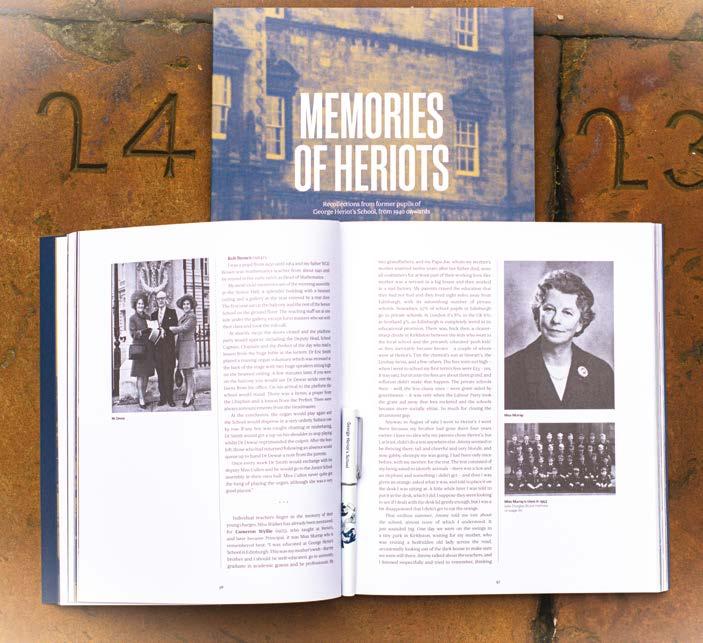
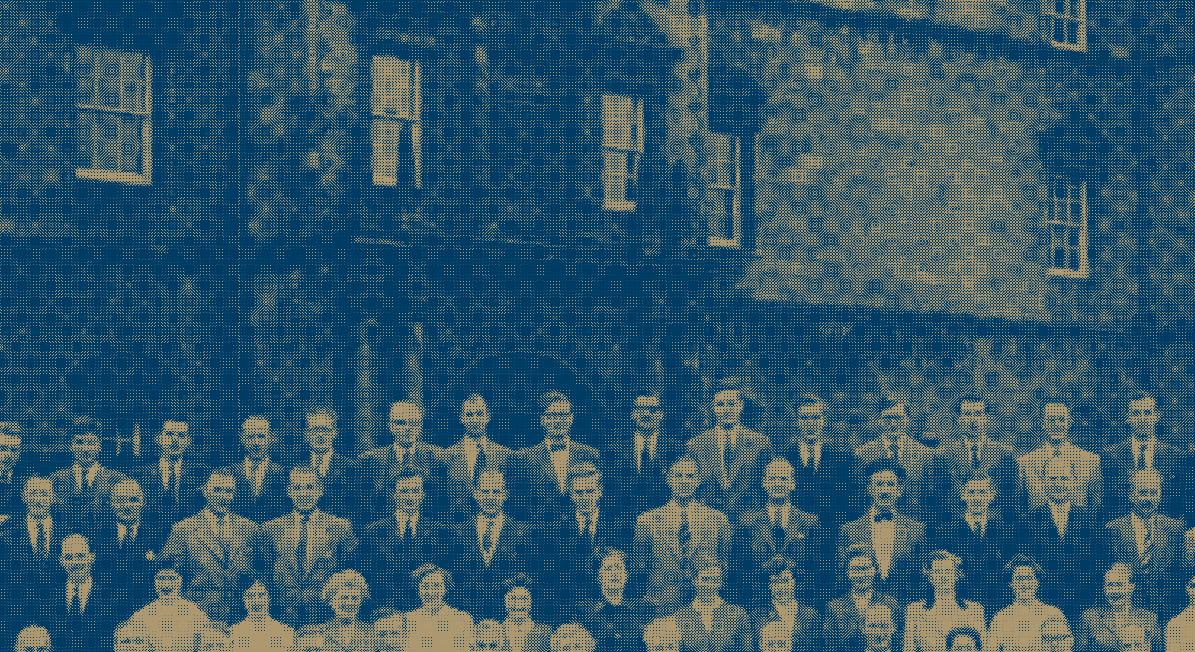
From war time air raid duties and bombwatching to stories about cracking milk bottles in the playground and the shocking consequences; from tales of memorable teachers and the notorious riding of a motorcycle into school; from the ‘12:10’ rush for lunch to playing the train times to one’s advantage, it is certainly a varied, unpredictable and fascinating read.
The wonderfully curated opus paints a familiar and nostalgic picture of the pathway that pupils from Edinburgh and beyond have walked over many Sessions during their formative school years.
This 180-page, 245 x 280mm-sized book costs £65 (+ P&P) and would make a superb gift for a fellow Herioter or an opportunity to personally purchase your own treasured snapshot in the 400-year history of the school.
Memories of Heriots can be purchased on the school website via the shop: www.george-heriots.com
2 Quadrangle
Welcome to Quadrangle 2023 Issue 43
Our new-look magazine brings you all the school news, stories, interest pieces and more. We hope that you like the refreshed design, a huge thank you to Richy Lamb for overseeing this for us.
Please do send us any news or stories you would like considered for publication. This magazine only exists thanks to the amazing stories that we receive from our Former Pupil community – we love hearing from you.
As we focus on the commemoration of George Heriot’s 1624 legacy and launch the We are All George Heriot campaign in 2024, an opportunity arises to strengthen our community, connections and distribute chearfullie. Read about the campaign, and how you can get involved on pages 18. We hope you enjoy this edition!
Contents
Development update
The Development team has welcomed three new members: Eilidh Hamilton as Development Coordinator, Darren Donaldson as Development Manager and Ailsa Purdie as Fundraising Executive. Julie Beattie remains on maternity leave. A fond farewell to Julz Colman and thank you to her for her good work on this edition. The team has been holding and planning events for Former Pupils, see ‘Past Events’ on page 8 and ‘Dates for the Diary’ on page 10, and of course the commemorations surrounding the We are all George Heriot campaign in 2024.
If we can assist you in participating in life after Heriot’s, be it staying connected, fundraising, or getting involved in the 2024 campaign, do not hesitate to contact us; dev@george-heriots. com, we look forward to working with each one of you.
Advertising
Quadrangle reaches former pupils, parents and friends of the school. To discuss advertising opportunities, please contact the Development Office.
Stay connected
T: 0131 221 6716
E: development@george-heriots.com
W: www.george-heriots.com/being-a-herioter
Herioter Hub
www.herioters.george-heriots.com
Write to us
Development, George Heriot’s School
Lauriston Place, Edinburgh EH3 9EQ
We hope you enjoy hearing from Heriot’s. If at any stage, you no longer wish to receive magazines, updates, and invitations from Heriot’s, just let us know.
The Development Team
Eilidh Hamilton, Ailsa Purdie, Darren Donaldson and Miranda Henderson.
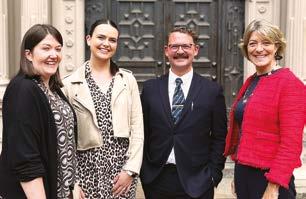
Quadrangle designed by Richy Lamb –www.richylamb.com. Printed by J Thomson.
Quadrangle packaging: the polylope enclosing the magazine is 100% recyclable. It is made from polypropylene, a waste product of the petrochemical industry and its make-up allows it to be included in general waste plastic recycling streams to be remade into alternative recycled plastic products. Recipients can put it into plastic recycling bins for collection by local council or waste collection services.
If you have enjoyed this copy of Quadrangle and would prefer to have received your copy by post, please email the Development Office at dev@george-heriots.com
George Heriot’s School is governed by George Heriot’s Trust. Scottish Charity Number: SC011463.
School news 2 Former Pupil news 5 2023 Former Pupil events 8 Join us and bring out your inner Herioter! 10 Herioter President transition 12 Making the most of the Herioter Hub 14 I Distribute Chearfullie – Foundation400 16 Giving Week 2024 18 Lines go back to the Founder 22 A Carefully Crafted Legacy 24 George Heriot: founder and Founder 26 One Hundred Years at Heriot’s 32 Casting a Legacy 34 Leaving a legacy in your Will 38 Love on Lauriston 42 A Herioter in Moscow 44 In Memoriam 48 Principal’s last word 52 1 george-heriots.com
School News
Meet the new School Captains
We are thrilled to introduce the new Captains for 2023/24, Amy and Thomas, supported by Esme and Alasdair as Vice Captains. We wish them happiness and success in their new roles within the Heriot’s community. We hope you will have the pleasure of meeting them at a future Former Pupil event or during the We are all George Heriot campaign activities. i
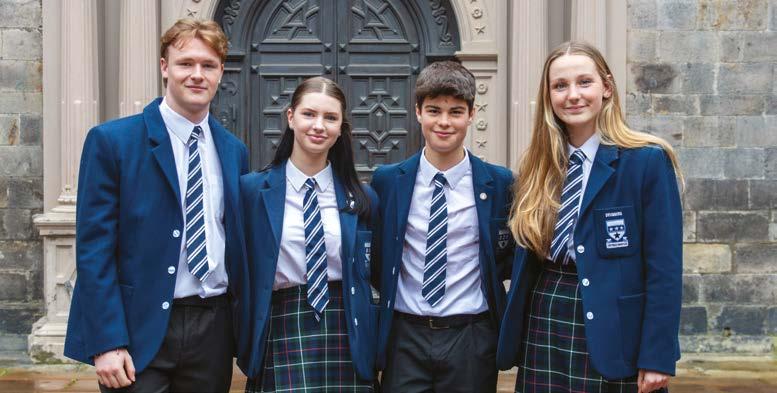
Rowing at Durham
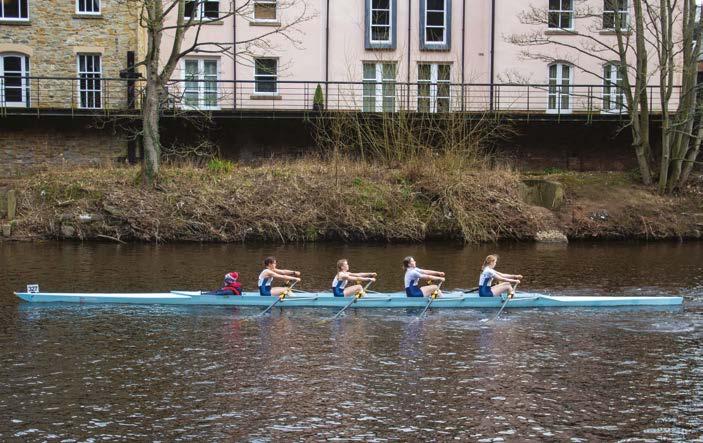
In February, 45 members of the school rowing crews from S3-S6 headed down to the River Wear to race at the Durham Small Boats Head; this is the most entries the rowing club have taken to a race. With over 300 crews racing from all over the North of England, it was a busy weekend for those involved. This event was a wonderful experience for the younger rowers to get a taste of racing. The rowing club managed to take away wins in 8 categories with some enjoying their first ever victory, and the Boys’ First Quad securing fastest crew of the day!
(see Bob Neill Tribute Dinner page 10). i
‘Plastic Smile’ to London Finals
Congratulations to Evangeline, Chet, and Daisy (S5), who created a fashion design made from recycled materials. Four teams submitted designs to the international competition producing fashion from throwaway materials. Heriot’s was one of the teams selected from Scotland as a finalist in the National heats of the competition in London.
It is the first year entering this competition and the pupils are thrilled with this success. i
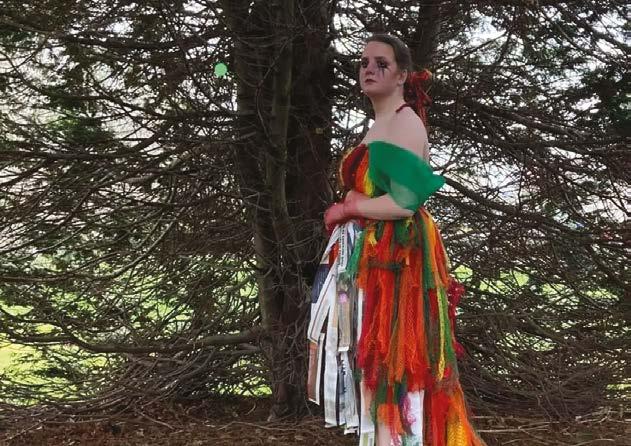
2 Quadrangle
Coronation Champion
Harriet (S3RE) has been awarded a Coronation Champions Award by King Charles III and Queen Camilla for her outstanding voluntary work at Bridgend Farmhouse. We spoke with Harriet after her award:

Harriet said, “It feels amazing to receive a Coronation Champion Award. I have been volunteering for just over a year at Bridgend Farmhouse and I absolutely love it, I started volunteering because I had visited the Bridgend Farmhouse Café on many occasions, and I enjoyed the friendly atmosphere and the diverse range of people who volunteer. My role involves liaising with other volunteers, how we are going to run the café that day to make it a welcoming and enjoyable space for people. Many volunteers have learning disabilities or mental health impairments, together we make an effective team and provide a muchneeded service to our community. I volunteer every Saturday; I look forward to seeing our regular customers; it is an opportunity for me to provide company and friendly chat to many people within our community who may be isolated or
UK Chemistry Olympiad
Three Heriot’s pupils participated in the Chemistry Olympiad challenge and did themselves proud. Lucy and Molly (S6) gained well-deserved bronze awards, whilst Heather (S6) received the prestigious silver award.
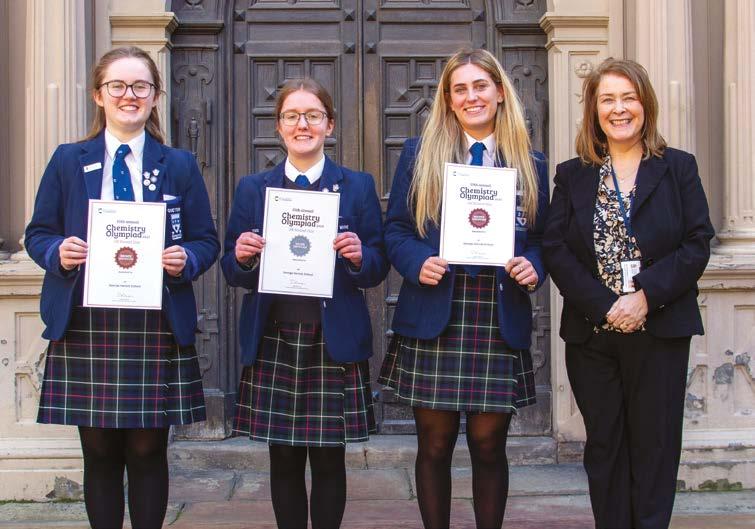
Designed to challenge and inspire, the UK Chemistry Olympiad is a unique opportunity for students to excel in chemistry. Budding chemists will develop critical problem-solving skills, learn to think more creatively, and get a chance to test their knowledge in new, realworld situations. They could even find themselves representing the UK at the International Chemistry Olympiad. i
just appreciate seeing a friendly face. I love the Bridgend Farmhouse Café's vision; learning, working, and growing together to develop a flourishing, healthy and sustainable community and place. Everyone is made
to feel welcome and included which is so valuable to the community it serves.
Volunteering is a positive thing to do and has been great for my confidence. I would recommend it to any young person.” i
3 george-heriots.com
Lego Club News – Donation Drive
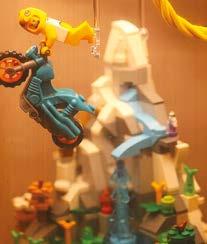
June Day –Oldest Herioter
The school is launching the new Senior School Lego Club this September and we need your help!

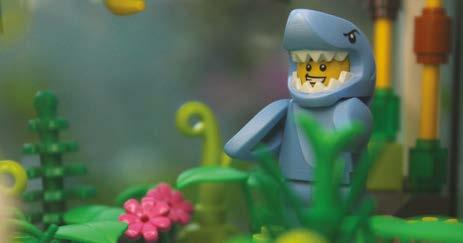
If you are a Lego fan you will already know it is a wonderful toy that brings joy and creativity to people of all ages. Whatever you are building, there is something incredibly satisfying about putting together a set of bricks and seeing your creation come to life.
Not only is Lego a fun way to pass the time, it’s also a great way to exercise your brain, improve fine motor skills and express yourself.
Orrin at the RA
Congratulations to Orrin (P3) on having his painting selected to be featured in the online Royal Academy Young Artist’s Summer Show. The online exhibition runs through the Summer. i

There are many reasons why you might consider donating Lego to the new Senior School Lego Club. Perhaps you have sets that you no longer use, and you would like to give them to others to enjoy. Perhaps you just want to share the joy of Lego.
Whatever your reason, donating Lego is a great way to give back to the Heriot’s community and spread some joy! If you would like to help support the Lego Club in any other way, we would love to hear from you. Thank you! i
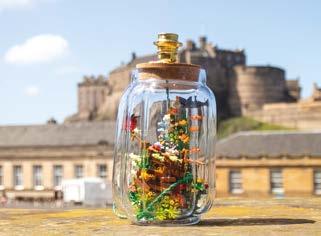
June Day evokes fond memories and emotions for Former Pupils of the school and is held dearly by so many.
This year we were pleased to welcome a very special guest to the celebrations. A Former Pupil whose first June Day was Monday 6 June 1927, at the tender age of 7.
Dr Lex Turner joined 24 other Former Pupils from across the years to watch current pupils walk in their footsteps. At the grand age of 103, Lex was delighted to have witnessed the class of 2023 being applauded out at the end of the event, nearly one hundred years after he first walked the grounds of Heriot’s.
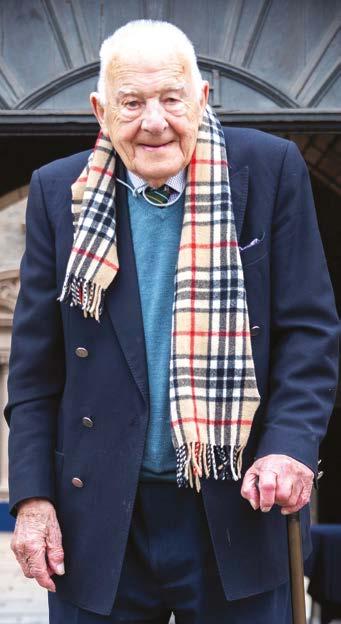
Afterwards, as we warmed up with a coffee, Lex regaled us with stories and memories of his time at the school. We were fascinated to speak with a veteran of WW2 who recalls so many memories of his service during the war. It was particularly moving to listen and bear witness to these recollections, especially the loss of his Herioter comrades.
A heartfelt thank you to Dr Turner for joining us, an inspiration to us all, sharp as a tac and fit as a fiddle. i
4 Quadrangle
Rainy Days by Orrin
Former Pupil News
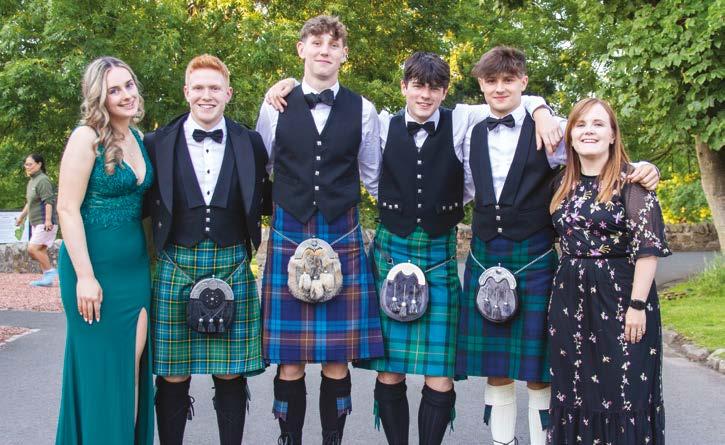
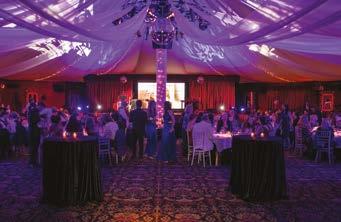
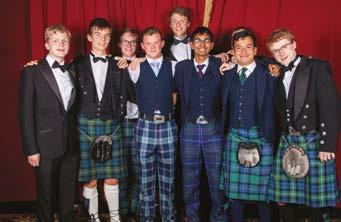
From our most recent Former Pupils

5 george-heriots.com
The class of 2023 celebrated the end of their school career and danced the night away at Prestonfield House. i
Charlotte's BAFTA Success
Congratulations to Charlotte Wells (2005) for winning Best Outstanding Debut by a British Writer, Director, or Producer at the 2023 BAFTA awards.
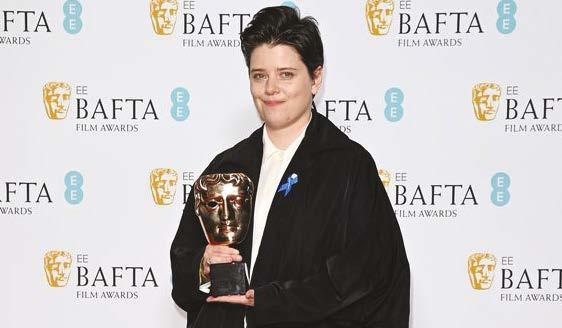
If you haven't seen her beautiful and thought-provoking film, Aftersun, we would strongly recommend watching it. Read a wonderful interview with Charlotte by Journalist Catherine Shoard at Charlotte Wells on Aftersun, The Guardian’s best film of the year: ‘The grief expressed is mine’. i
Through the Lens
David Ho recently got in touch via the Herioter Hub to ask a few questions about the platform, and we fell hook, line, and sinker for his photography. Here is what the Former Pupil had to say:
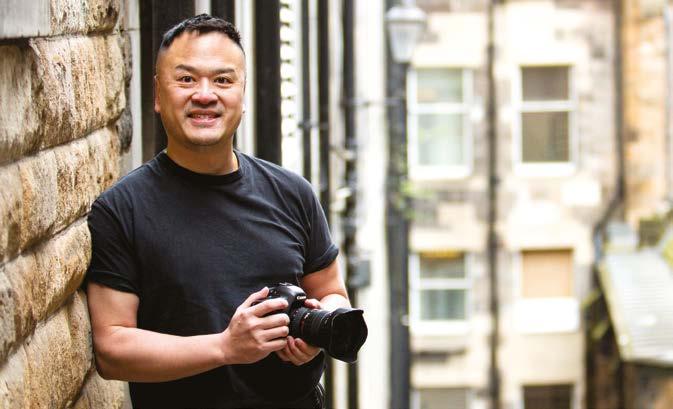
"If there was a ‘no wrong path story’ for the ages, mine would be close. After gaining work experience with a veterinary practice while still at Heriot’s, I went onto Dundee University to study Accountancy and had a blast living with bohemian artists in the ‘city of jute.’ After graduating, I secured a placement with a management consulting firm, but office life and spreadsheets never sat well with me. With my visual and creative side calling, I ditched the 9 to 5, and dived into commercialising my hobby of photography, gaining
Henry Raeburn's Edinburgh
experience in schools' photography and then wedding & family photography with a well-established Edinburgh photographer. Within a year I was gaining dozens of my own clients. My portfolio grew and within a couple of years dozens become hundreds. After 800+ weddings and nearly as many family portraits in 20+ years, I am now primarily headshot & portrait photographer with many of my clients coming from the world of business, politics, acting and sport. I can still be persuaded by friends to shoot the occasional wedding and family portrait. Very occasional.” i
www.headshotsscotland.com
www.forestlightstudios.co.uk
To mark the 200-year anniversary of his death, Former Pupil and one of Scotland’s greatest artists Henry Raeburn has a new exhibition celebrating his life and work. Raeburn’s Edinburgh is on at The Georgian House, Edinburgh until November 2023. i
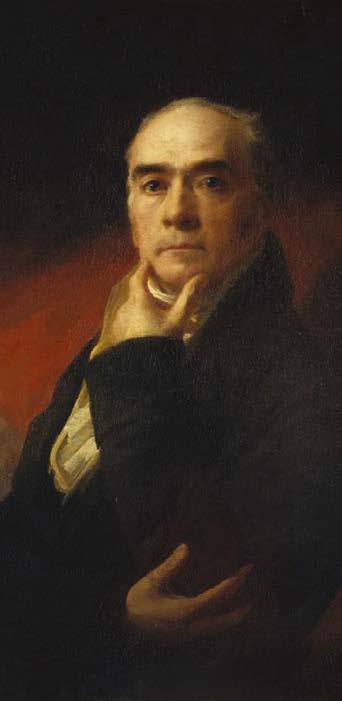
6 Quadrangle
Poetic voice
Calling all curlers
or teachers. We are particularly keen to attract former members of the School Curling Club.

Over the season we compete in an FP league against Watsonians, Stewarts Melville FP and Edinburgh Academicals – as you can imagine there is a quite a lot of friendly rivalry and banter in these matches as we all like to win against the “Auld Enemy”. We also have a couple of friendly matches and some other competitive matches.
Congratulations to Kate Millar, (2018). Kate is part of the 2023 cohort of ‘Scotland’s Next Generation Young Makars.’
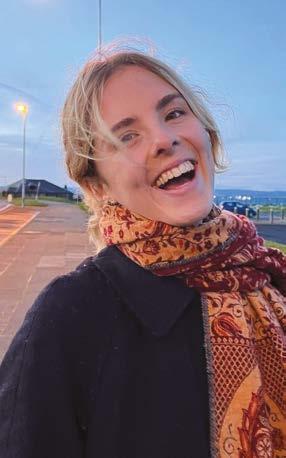
On being awarded Kate commented ‘It is hard to say succinctly what I love about poetry. It is language and imagery cracked open, turned on its head, liberated and surprising. It is the gift of attention. An invitation to meditate on beauty, pain, tension, paradox. It draws us from the surface of our lives to the depths. It is prayer.’
Below is a poem very kindly shared by Kate for this issue of Quadrangle:
She Sits By the Reservoir
With eyes like opals set in granite, a woolen coat and scarf, bare hands
to see by touch, feel the soft curve of a pebble in her palm: the line
of hills––and the cool flow of water over her fingers is the light
that filters through leaves. i
We are a small club and looking for new members of any age – either former pupils, family members or those connected with the school such as parents
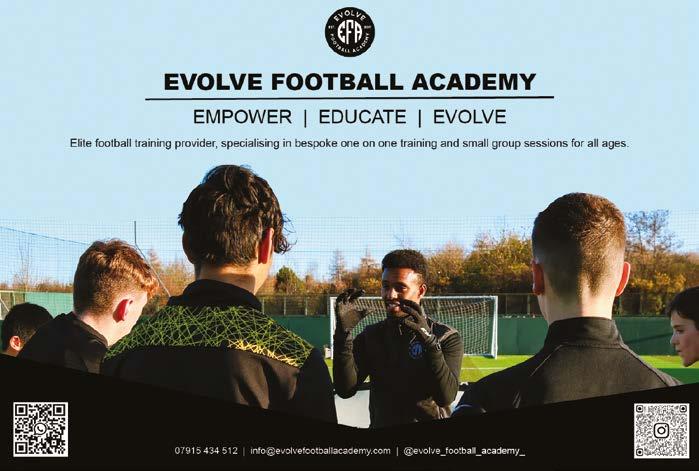
If you are interested or would like some more information, please contact Malcolm Wright (Club President) at hmwright@blueyonder.co.uk or Douglas Goddard (Club Secretary) at dougie. anne@btinternet.com or visit the Club's website at www.heriot-curling.org.uk.” i
Border’s Heriot’s Club’s Annual Dinner
The Border’s Heriot’s Club’s Annual Dinner will be held at The Lodge, Carfraemill near Lauder on Friday 27 October 2023 at 7.00pm for 7.30pm. This is our 67th dinner and your attendance would be most welcome. Please try and bring a friend or two along with you to make the evening even more enjoyable. The ticket price for this year’s dinner will be £34 per person and £240 for a table of 8.
It would be brilliant to see a good turnout this year, building on the great attendance of last years’ dinner at Carfraemill. i
Tickets
Please contact Hugh Henney hugh:henney1@gmail.com
NB Dress code for men is jacket and tie
7 george-heriots.com
2023 Former Pupil events A busy year in review
One Birdcage Walk, London
A Drinks Reception for Former Pupils took place in the beautiful library at One Birdcage Walk in May. With the sun shining and views overlooking the magnificent St James Park, the drinks and conversations were flowing at this evening reception at which more than 60 Former Pupils were in attendance. It was great to see Former Pupils from all classes re-connect as well as make new Heriot connections on the night whilst shining a light on the Foundaton400
After Many Years Reunion
In late May, we were delighted to welcome back 80 Former Pupils to the School for the After Many Years Reunion. This event was for Former Pupils who left the School 50 years ago or more, with many attendees travelling
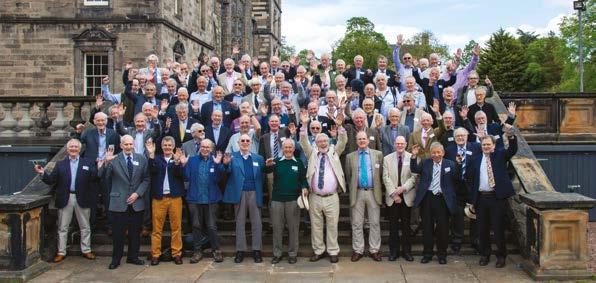
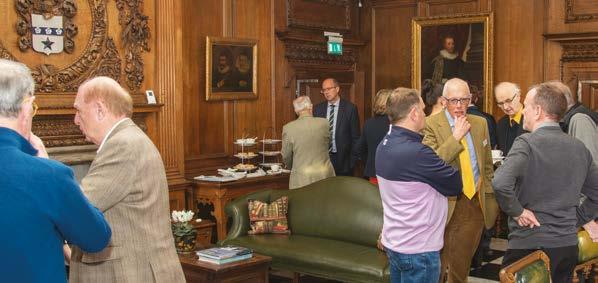
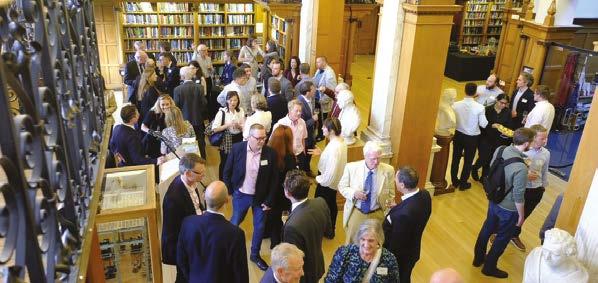
far and wide to be there. Those that came reminisced about their time at Heriot’s while enjoying a tour of the school followed by a lovely lunch in the Refectory which ended with a fantastic and entertaining speech by Denis Batts (1967) and a look at the archives and old class photos.

Coffee Mornings
Our monthly Coffee Mornings are proving popular and it’s been great seeing so many of you back at the school for these. We have thoroughly enjoyed hearing your fond memories and mischievous tales from your time at Heriot’s, as well as your stories of your fascinating career journeys since leaving.
These Coffee Mornings take place on the last Wednesday of every month from 10:00 – 12:00 in the School’s
exclusive Council Room. For more details or to book in for one of the next Coffee Mornings, please visit the Herioter Hub or contact the Development Team by email on dev@george-heriots.com or by phone on 0131 221 6716.
June Day 2023
June Day is a major celebration in the school calendar where staff, pupils, parents, and Former Pupils come together to celebrate the legacy of George Heriot. With limited tickets available for FP’s through the Herioter Hub it was lovely to welcome back 25 Former Pupils for this year’s June Day celebrations. Former Pupils in attendance were from the classes of 1937 through to 2022, including our oldest Former Pupil, aged 103. i
8 Quadrangle
THE
SCHOOL SHOP IS NOW UP AND RUNNING!
You can find it in the shop section of our website. We have lots of products for Herioter’s old and new including water bottles, umbrellas, and mugs.
CUFFLINKS AND CHARMS
Beautifully crafted from a handmade die commissioned by George Heriot’s School depicting the principal elevation of the Quadrangle. These cufflinks and charms make a wonderful gift for school leaver, a special birthday, anniversary or retirement. Available in gilt (£250) or silver (£225) + P&P from end September.

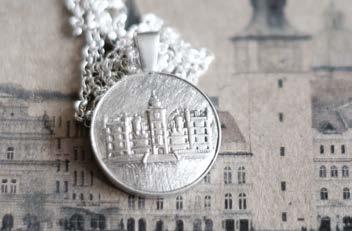
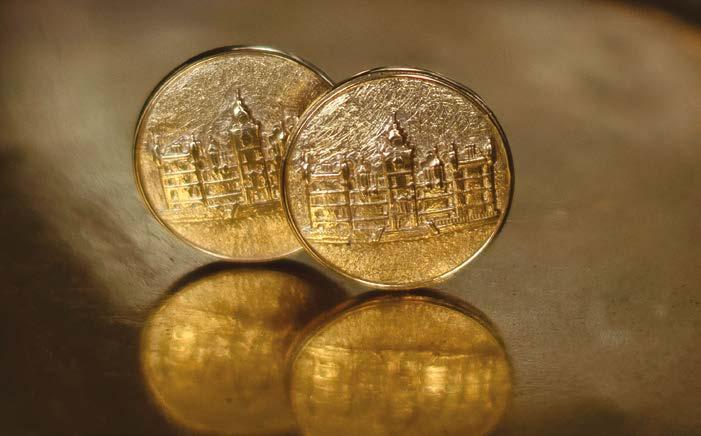
The charm can be worn on a bracelet or necklace and is available in gilt (£170) or silver (£150).
Please allow 4-6 weeks from placing order to receipt of goods, while stock levels are built.
www.george-heriots.com/shop
£150 FROM £18
I DISTRIBUTE CHEARFULLIE NOTEBOOK
A lovely notebook gift for Herioters. A handy A5 sized, moleskin notebook with hard cover and lined interior pages on both faces.
JINGLIN GEORDIE LEGACY BOOK
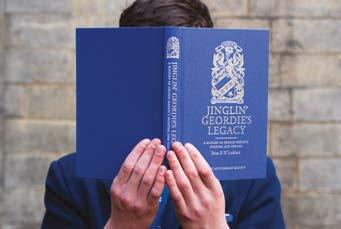

A 440-page history of George Heriot’s School, written by former pupil Brian Lockhart and later Principal Teacher of History under Dr. Dewer.
HERIOT'S HISTORY MUG
Lovingly hand-made, hand-painted bone China mug, full of Heriot’s history.
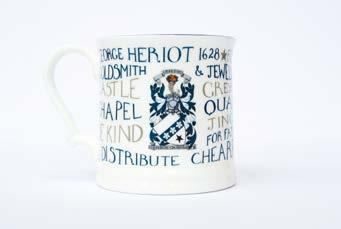
9 george-heriots.com
£24 £18
Join us and bring out your inner Herioter!
We are growing Former Pupils events with the aim of offering something for everyone. Some events are part of a series, such as the Coffee Mornings. Others are individual events to thank, recognise or commemorate different strands of the wonderful Herioter community. All events can be booked via the Herioter Hub from today.
Coffee Mornings
teacher Bob Neill, to recognise his impact on rowing at Heriot’s and on the wider rowing landscape.
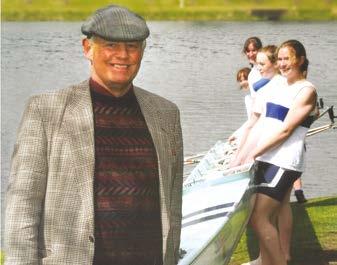
The Development Team welcomes Former Pupils to any one of the monthly Coffee Mornings taking place in the Council Room from 10–12pm on the last Wednesday of the month. Please come and join us for a chat, a pastry, and a look at artefacts from the archive. To attend please register via the Herioter Hub so we buy enough pastries!
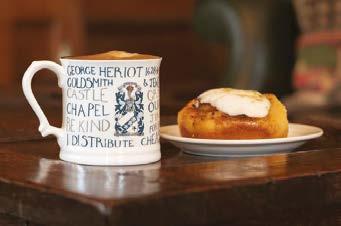
Bob Neill Tribute Dinner
Friday 6 October 2023, 6.45pm – late Champagne Reception and three course dinner at George Heriot’s School
An evening to honour the life of former Rowing Master and Physics
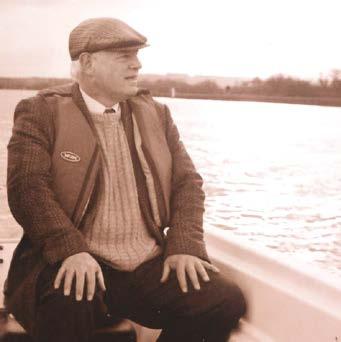
Bob Neill was Head of Physics and Master of Rowing at George Heriot's for 37 years. His face was a regular presence at rowing events in Scotland, even after he retired. His legacy continues today with Heriot's Rowers achieving success at national and international level, along with 4 pupils gaining full rowing scholarships in America over the last 3 years. All this under the leadership of the school’s dedicated rowing coach, James Davidson.
The
a
by a three
be an auction, an exhibition of rowing at George Heriot’s School plus plentiful rowing and physics talk! Former Pupils and other names in the wider Scottish Rowing community, including Ben Helm and Polly Swann, have already signed up. All money raised through ticket sales and donations will go towards a new quad boat named in honour of Bob, as well as the creation of a rowing hardship scholarship and a future rowing pathway, securing Heriot’s continuing status as one of Scotland’s centres of rowing excellence. Event details are on the Herioter Hub. NB tickets are going fast!
10 Quadrangle
Tribute Evening will feature
champagne reception followed
course dinner. There will
London Drinks Reception
Thursday 23 November, 2023
George Heriot's School will be back in London on Thursday 23 November for a lovely evening of networking, raising money and shining a light on the Foundation400.
In attendance will be Gareth Warren, Principal and members of the Development Team. Entry is by prebooked ticket only and tickets are available through the Herioter Hub.
Please tell any Herioters you are in touch with to join us and help us to raise funds to enable more Foundationers to attend the School.
Usher Hall Christmas Concert
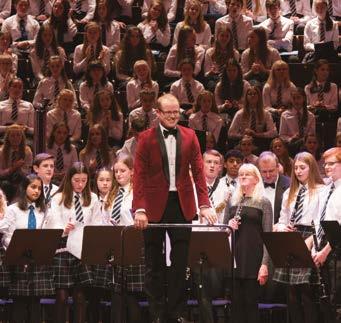
Tuesday 12 December, 2023
1628 Society – Afternoon Tea 3–5pm
Thursday 21 March, 2024
We welcome members of the 1628 Society to join us for a special Afternoon Tea at George Heriot’s. This is an opportunity for the school to express its heartfelt thanks to those potential legators that have committed support to the school in their Wills.
Join us and fellow 1628 Society members to hear school news, share memories and talk to us about what George Heriot’s means to you. A small memento that recognises your contribution will be available for collection on the day.
Invitations will be sent directly to members of the 1628 Society.
Edinburgh Drinks Reception
Dovecot Studios Edinburgh
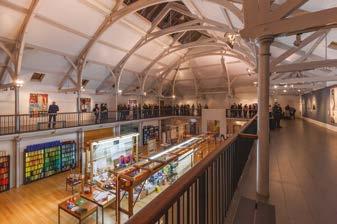
Thursday 18 April 2024, 5:30pm – 9pm
by a buffet lunch served in the refectory, speeches, and a look through archives. Further event details for Former Pupils who left the school between 40 and 50 years ago, are available through the Herioter Hub. Book early to avoid disappointment.
June Day
Monday 3 June
Celebrations will begin at 10am, parents and Former Pupils are invited to join us from 9.30am. Further details and booking for Former Pupils will be available via the Herioter Hub.
We are all George Heriot ‘Giving Week’ Tuesday 4 – Saturday 8 June
We welcome members of the 1628 Society and Donors to join the George Heriot's School Development Team for a festive tipple at Lauriston Place before heading to The Usher Hall to enjoy the annual School Orchestra Recital.
– Arrival to School Staff Room for 5pm
– Depart School 6:15pm
– Seated for Concert: 6:45pm
– Concert begins: 7pm
Please note guests will be expected to make their own way to the Usher Hall.
George Heriots is delighted to invite Former Pupils to a lovely evening of networking, raising money and shining a light on the We are All George Heriot Campaign at the impressive Edinburgh Dovecot Studio.
In attendance will be Gareth Warren, Principal and members of the Development Team.
After Many Years Reunion 1974–1984
Saturday 18 May, 11am – 2pm
After the success of the 2023 After Many Years Reunion, George Heriot’s is delighted to invite the classes of 1974 – 1984 inclusive for a day of celebration, reconnection, and, the sharing of memories.
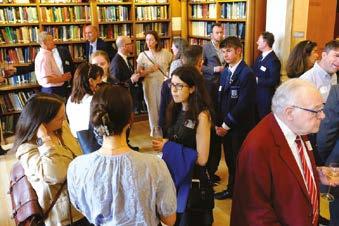
The day will encompass a tour of the campus, a drinks reception followed
Celebrating 400 years of George Heriot’s legacy 1624 – 2024
Join the week of fun Fundraising activities across the school and wider community as we commemorate George Heriot’s Legacy. (See p18 for more details.). i
11 george-heriots.com
Herioter President transition
Jac Pentland passes the baton to the new Herioter President, Morgan Jamieson.
Jac Pentland (1997) has completed her two-year tenure as Herioter President. We are incredibly grateful to her for her attendance at Former Pupil and School events over the past two years, and for the time she has made to meet so many of you.
A request for candidates to stand for Herioter President was made in the Autumn 2022 issue of Quadrangle. Very sadly we had no volunteers for the post.
The good news is we have found someone who is prepared to take up the role and is perfect for it. A huge welcome to the new Herioter President, Morgan Jamieson (1965). We all very much look forward to working with Morgan, as he looks forward to meeting many Former Pupils too.
‘It is hard to believe that my two-year tenure is nearly finished. It has flown by, and has led me to ask, “what has the last couple of years brought”?
The slow and careful lifting of covid
restrictions which means the school has been able to open its doors again to returning FP’s who have been gathering enthusiastically at events such as the 10Year and After Many Years reunions.
I feel that the pandemic has changed how we meet. Less formal and more frequent opportunities to pop into school is a welcome addition to the social calendar and I encourage FPs to take advantage of the invitation to join senior management and the Development Team for a coffee and a chat.
The use of technology continues to help connect us with one another. We have grown accustomed to Zoom and MS teams and the launch of the Herioter Hub app has been a timely addition to our digital repertoire. At last count we have 1,879 formal pupils on the Hub which means that the online Herioter family has a far wider reach than ever before.
It has been a genuine honour to
represent the Herioter community. I have loved attending school events, from the solemnity of Remembrance Sunday to the dignity of Founder’s Day.
I was brought to tears by the combined pipe band and orchestra’s rendition of Amazing Grace at the Christmas Usher Hall concert, have had fascinating glimpses into the inner working of the school during development committee meetings and been fortunate to work alongside the school’s fabulous Development Team.
The next couple of years for Morgan Jamieson, your next Herioter President, will bring even more engagement opportunities as events are in the pipeline for 2024 to commemorate 400 years since the death of George Heriot.
I wish Morgan every success in the role and I’m sure he’ll be a wonderful representative of the FP community.
My son will be disappointed that I’m passing on the baton. I have reassured him, though, that although I won’t be “president of the school” (his moniker) I’ll continue to embarrass him at as many school events as possible.’
– Jac Pentland
‘Class A with Miss Murray in 1952 may have marked my introduction to George Heriot’s, the school, but it was my father’s sudden death, four years later, that created for me an abiding sense of connection to George Heriot the man. Through the support of the
12 Quadrangle
“The next couple of years for Morgan Jamieson, your next Herioter President, will bring even more engagement opportunities as events are in the pipeline for 2024 to commemorate 400 years since the death of George Heriot.”
Foundation which sustains the ongoing legacy of his foresight and generosity, the otherwise impossible became possible. Despite very altered financial circumstances, I was able to continue my education uninterrupted and, in parallel, maintain the friendship of classmates, twin benefits that provided an invaluable measure of stability in a season of substantial change. A letter to my mother from the then Junior School Head, Mr Galloway (still in my files!), offers eloquent testimony to the consideration and support the school provided through these difficult times. I like to think Heriot would have been pleased.
In due course, assisted by Mr Park’s teaching of biological science, school was followed by a medical degree at Edinburgh University and a subsequent career in cardiac surgery. Initial training in Edinburgh, Great Ormond St. and Johannesburg led, in 1983, to a consultant appointment in Glasgow working between the Royal Hospital for Sick Children and the Western Infirmary. Changes in NHS organisational
structures during the 1990s brought involvement in hospital management and subsequent appointment, in 1998, as Medical Director of the Yorkhill NHS Trust. Consequent upon the impact of a further round of political decisions, including the dissolution of NHS Trusts, the latter four years of my professional career involved concurrent roles participating in the planning of the new Royal Hospital for Children in Glasgow and working with the Scottish Government as National Clinical Lead for Children and Young People’s Health.
Retirement has already offered opportunity to work with the local Children’s Panel, to pursue a research degree in theology and to serve for several years as Trustee and Chair of the Nazareth Trust - as well as marginally steadying my golf swing. The unexpected privilege of now having been invited to take on the role of Herioter President for these next two years is as humbling as it is daunting as it is exciting.
The role is primarily intended to foster links between Former Pupils and the School to the benefit of both. While
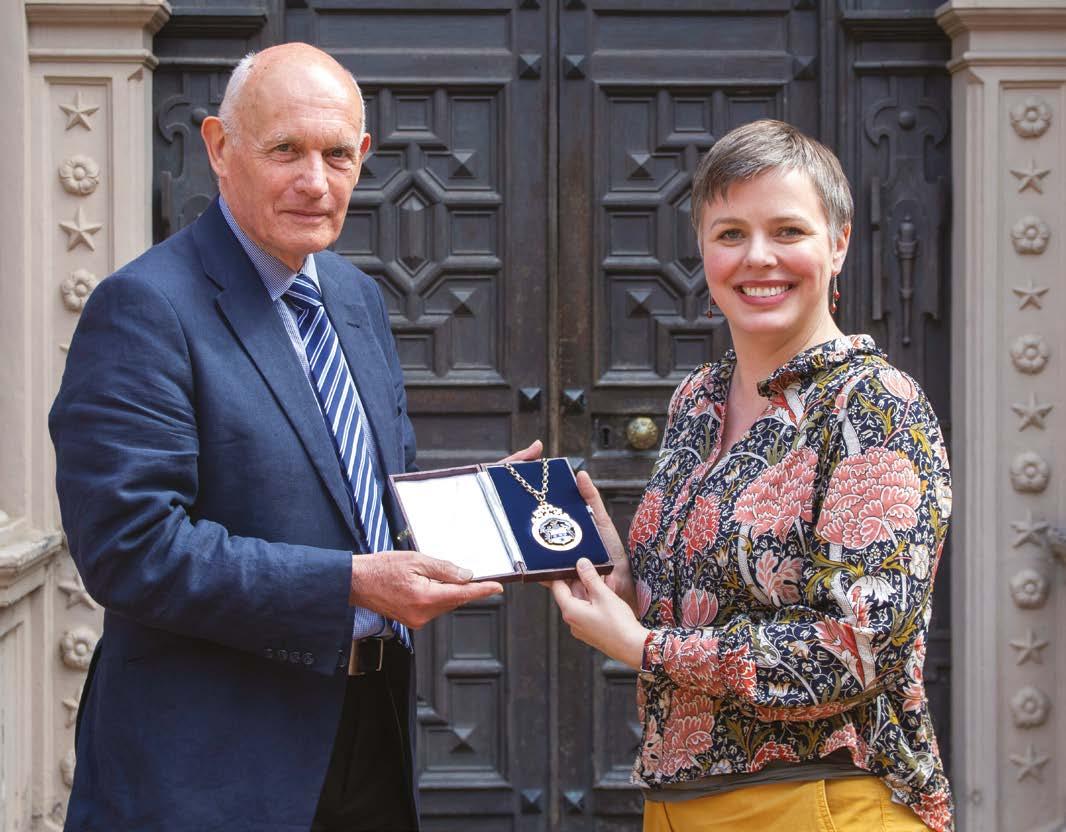
Herioters may represent a demographically and geographically scattered community it is a community marked by an abiding sense of loyalty and gratitude. It is also a community that incorporates a vast reservoir of talent, experience, and resource. Building on the sterling efforts of Jac Pentland, Richie Adams and others who have previously held this role, it would be my hope to further enhance the links between Former Pupils and the School in ways that both strengthen that sense of community and enrich the work of the School and, in so doing, maintain and freshly express something of Heriot’s vision and legacy - an aspiration that has particular relevance as we commemorate the 400th anniversary of his death next year.
I look forward to meeting many of you over the next two years, to sharing stories of the past and hearing ideas for the future. Beyond that, at all times, please feel very free to contact the Development Team or myself (FPpresident@georgeheriots.com) to explore how you might be more involved.
– Morgan Jamieson i
13 george-heriots.com
Over 1,902 online members in just 14 months plus 68 mentors signed up 9 regional groups 14 professional groups 18 special interest groups
Join the Hub today and build connections across the Herioter community, access career opportunities, enjoy events and reunions, upload thought pieces and explore ways of supporting Herioters around the globe. All by creating a simple profile. Making the most of your Herioter Hub Visit the Herioter Hub at www.herioters.george-heriots.com Enter your preferred email and create a password (You can sign up via Facebook, LinkedIn, Google, or Apple) Type in your name, go through the questions and at the end, you will be linked to your school record Upload your photo Tell us all about yourself Consent to contact – email, letter, or telephone – you are in control How do I sign up? Top Facts 1 2 3 4 5 6
14 Quadrangle
Once a Herioter, always a Herioter
The school’s global network of Former Pupils is a vital component of life at Lauriston Place and in taking the Heriot’s name and ethos out into the wider world. The Development Office role is to keep Former Pupils and friends of Heriot’s involved in the life of the school, and in contact with one other.
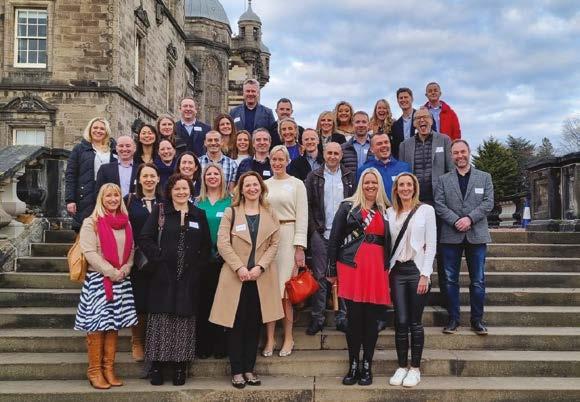
What does The Hub offer you?
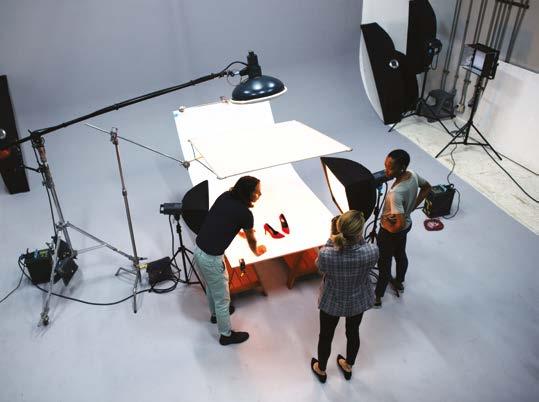
Regional Clubs, such as Herioters in the USA, Asia, Europe, Africa, and South America. Our Australia Club is one of the most active regional clubs this year, holding their own June Day lunch, quizzes and get togethers. If you are willing to head up a regional club, please let us know.
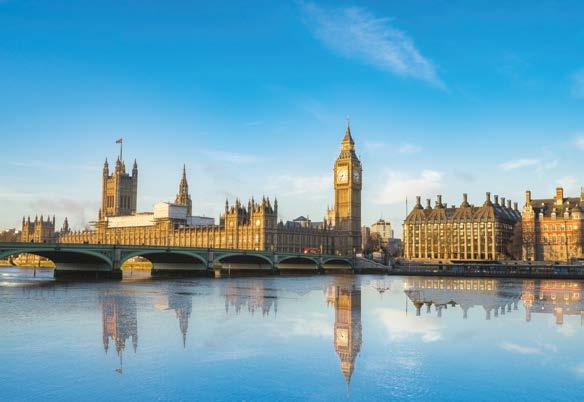
The Sports and Interest Groups offer many activities to connect with other Herioters, from Cycling, Rowing, Winter Sports, Rugby, and Hockey to Pipes & Drums. Why not help us launch a club that is relevant to your interests, and connect with Former Pupils? A debating club, wine club, or even a Herioter’s Book Group perhaps?
Professional groups. As Former Pupils you will know how useful connections to other Herioters can be. Use the Hub to network with people in similar lines of business, industry, and expand your professional network. The Hub offers an expansive range; Lawyers, join our Law Network, Entrepreneurs, meet likeminded startups. Or why not get involved in the ‘Leading Thinkers’ or ‘Environment & Sustainability Network’? You can also add your own business to the Business Directory – this is free to Herioters.
Find Classmates. Currently there is a link in the Hub for every year group! Find your year, join, invite your former classmates to sign up. We have found many Former Pupils reconnecting with classmates otherwise lost to the past.
One of our most popular tools has been the Archives portal, where we can aid in Family Research, or help you explore the history of the school. By signing up today, you can keep abreast of all that is being shared and discovered by Former Pupils about the school.
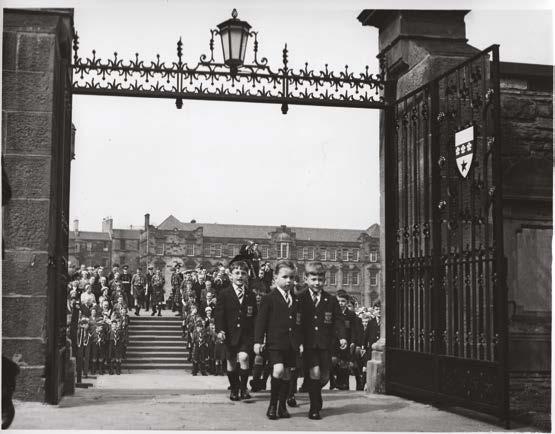
15 george-heriots.com
Heriot’s vision of ‘distributing chearfullie,’ of generosity, of kindness and of support remains at the core of the school’s ethos today. It has enabled generations of children to benefit directly from the generosity of the Heriot’s Foundation. All of us are better off for belonging to a school that cares, and the school community is honoured to welcome foundation pupils from P6-S6. It costs Heriot’s more than £900,000 per year to fund Foundation places, which comes from school fees, donations, and legacies. Fee income is also needed to realise the plans that reinforce Heriot’s reputation as one of Scotland’s finest schools. Endowing the Foundation with £15 million will ensure the school can fund Foundation places forever.
Can you help us reach this goal, to secure George Heriot’s vision in perpetuity? Please take a moment to read some heartfelt thoughts from those connected to the Foundation.
How is the Foundation400 campaign doing?
The Foundation400 campaign, to raise £15 million to fund the education of Foundation pupils in perpetuity, is accumulating. As of June 2023, the fund reached over the £3 million mark and continues to grow.
Heartfelt thanks to all current parents, former pupils, staff, and friends of the School who support this important campaign to secure the funding of Foundation pupils for the foreseeable future.
We are incredibly grateful to you.
£3,5000,000 £3,000,000 £2,500,000 £2,000,000 £1,500,000 £1,000,000 £500,000 2016/17 2017/18 2018/19 2019/20 2020/21 2021/22 Foundation400
£3,050,922 £2,923,664 £2,367,094 £1,991,700 £1,200,650 £889.417 16 Quadrangle
Support 2015–2022
Gareth Hydes (1986)
My Dad died when I was 9, and my whole world was turned upside down. Everything had to change. There was no grief counselling in the late 70’s, and as my Mum didn’t work, we had to sell the family home, and move into a small flat on the other side of town. Life suddenly became very different. My Mum was constantly worried, while trying to cope with the loss of her husband. A chance conversation on a bus, and we were told about the Foundation at Heriot’s. We applied and I was accepted and the following August I started in Mr Bob Smith’s P7 class right at the top of the turret in the Old Building. From that very first day, I instantly felt at home and welcome. The history, tradition, confidence, and presence in the School didn’t replace my dad, but it definitely gave me a crutch to lean on when times were tough. The School was always there – teachers to talk to, friends to help you and amazing experiences to get involved with. Life was still a struggle, but quietly and without fuss, Heriot’s supported me practically and emotionally. The greatest thing about being a Foundationer at Heriot’s was that you were made to feel special but never different. For this experience, which I’ve no doubt changed my life, I will always be grateful
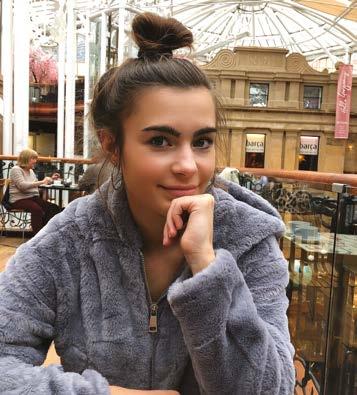
Ingrid McKay (2003)
When I joined Heriot’s in 1991 as a 5 year old, life was very confusing. Being so little, I don’t think I really grasped what had happened to me, where had my parents gone? Why had they not come
back to get me yet? Then I arrived at this enormous school, the Old Building looming grey and I met my new teacher, Mrs Wood. There was a desk with my name on it and a feeling of belonging slowly began to take hold. As I got older and learnt more about the history of the school I began to realise that the school needed children like me and we had a special name: Foundationers. We were an integral ingredient in the recipe of what makes Heriot’s such a special place. It was built for children like me and my brother and sister, who had suffered loss. And it wasn’t just us! There were more Foundationers and we all shared this experience. It was important for me to know that I wasn't the only one; it gave me comfort and from that comfort grew confidence. Confidence to be myself and to know that I mattered, that what happened to me mattered. And that good could come of it.
people distributing cheerfully. And the results last a lifetime. I will forever be grateful for the 12 happy years I spent as a Foundationer and for all Heriot’s gave me.
It’s nearly 20 years since I left Heriot’s and I now have four daughters of my own. As they embark on their own school journeys I find myself reflecting on my time at school. It has all the ingredients of a fairytale: young girl loses her parents in separate unforeseeable circumstances, ends up being sent to a fantastical, magical school with turrets and secret tunnels, legends and ghosts. She finds happiness and friendships there, a sense of belonging and is able to excel. But really, the magic doesn’t come from fairy dust or potions, it comes from people's generosity and kindness. It is people that make Heriot’s,

My father lost his battle with nonHodgkin’s lymphoma when I was ten years old. I moved to George Heriot’s school the year after and am truly so grateful for the education and experiences that I was granted when I was there, many of which simply would not have been possible without the Foundation. I was lucky enough to try one-to-one music lessons and have my school trip to Shanghai in S3 subsidised, which was ultimately formative in my choice to study Mandarin at the University of St Andrew’s. In addition to these wonderful experiences, I felt supported every day in ways that were so important to a child whose world had truly been turned upside down and allowed for some certainty when one of the most stable relationships in my life had gone. Knowing that my education was secured and that there was a space for myself and peers that had been through similar experiences lessened my feeling of isolation and was integral in rebuilding my confidence.
The Foundation scheme is a true demonstration of kindness and the payit-forward concept. I am so proud of my status as a former-pupil and Foundationer and consider myself extremely fortunate for the start and opportunities that it gave me. I have every intention of donating when I am able, as I know how important the cause is for children that have suffered such a significant loss. i
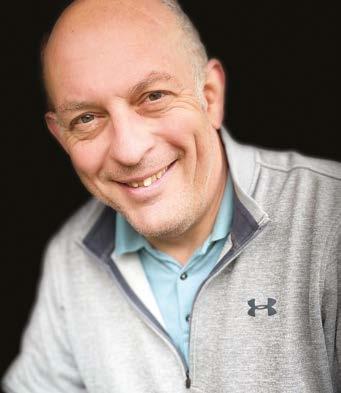 Maddy Counsell (2021)
Maddy Counsell (2021)
17 george-heriots.com
Giving Week 3–8 June 2024
Can you help us?
400 years ago, Clan MacDonald was at war with Clan Chief MacFie for control over Argyll and the Isles; closer to Edinburgh, eleven women accused of witchcraft were drowned in the Nor Loch, and King James I & VI was in his final years as the first King to rule over Scotland and England. All the while, Scotland’s earliest philanthropist, George Heriot, was hatching a vision. A vision that remains very much alive today.
On returning from a visit to Christ’s Hospital School in London where George was witness to the Hospital’s benevolent endeavours, George began his venture to replicate this philanthropy in his home city of Edinburgh. In particular, he was impacted by the provision of food, clothing, lodging, and learning for 500 of London’s children, many fatherless or poor men’s children. George decided to use his wealth to springboard a similar establishment in Edinburgh, bequeathing the whole of his extensive fortune ‘for the education, nursing, and upbringing of
youth, being puir orphans and fatherless children of decayet burgesses and freemen of the said burgh, destitute, and left without means.’ The rest as they say, is history!
This historic connection to Christ’s Hospital is not lost. If one looks up at the carved panels above the Pend entrance, you will see one of the four friezes depicting five boys dressed in the uniform of Christ’s Hospital with their guardians. You will note the motto SIC DEUS, UT VOS EOS (may God treat you as you treat them), framing the young boys.
In 2024, George Heriot’s School celebrates the 400-year anniversary of Heriot’s legacy (the publication of his Will) and the announcement of his intention to fund a school for Edinburgh. This anniversary is an incredible opportunity for celebration, as the School comes together to commemorate, honour and echo George’s transformative vision to harness the power of education and extend its reach today. All with as much laughter, fun and fundraising as we can channel!
The School motto, ‘I distribute Chearfullie,’ also the Heriot family motto, is imprinted in the DNA of all Herioters. Showing kindness and giving support to others is part of the school culture, from individual acts of kindness like collecting for local foodbanks, to
18 Quadrangle
gathering medicines and blankets for the Ukraine appeal, to the work of the S6 Voluntary Service Programme, where pupils help others inside and beyond the school walls. This largesse does not stop when pupils leave. The many examples of Former Pupils whose actions spread George’s motto to ‘Distribute Chearfullie’ in their communities and across the globe is another article for a future Quadrangle and an inherent part of being a Herioter.
What are we hoping to achieve in 2024?
In June, George Heriot’s will be celebrating the impact of our founder’s legacy with a series of special events embedded in a Giving Week programme.
Giving Week presents a great opportunity for everyone associated with Heriot’s – current and former pupils, staff, parents, and friends – all who hold the School ethos dearly, to come together as a community and create something memorable and ultimately philanthropic.
During Giving Week, our aim is to echo George’s legacy by raising funds for the school’s Bursary Programme. This programme offers full and partially-funded places at Heriot’s for exceptional pupils who would otherwise be unable to attend.
For one pupil to attend from S1 – S6 on a fully-funded Bursary costs £98,640. Through Giving Week we hope to secure sufficient donations to ensure at least one fully-funded bursary place is available for an additional student(s) to attend Heriot’s from 2025–2031.
Our bursary places ensure there is limited financial burden on the family of the pupil. In addition to fees, Heriot’s offers financial support for uniform, sports kit, trips and academic books. Every single donation from you, no matter what size, helps in achieving this goal.

Each year Heriot’s funds £1.5 million in Foundation and Bursary places. The School receives numerous applications for bursarial assistance, sadly too many to support every applicant.
Heriot’s has always welcomed pupils from all walks of society and is proud of its socially diverse pupil body. For children for whom academic success is important, Heriot’s offers an educational choice that is accessible, academically balanced, and proven.
Bursary and Foundation students come from a wide range of backgrounds and circumstances, each facing their own challenges, both emotional and financial. Heriot’s supports these students
to ensure that a first-class education is not something they, or their family, must worry about.
To provide a sense of who the School supports and the challenges which might typically be faced, the following are anonymised scenarios from past years:
• Heriot’s was proud to support two pupils whose widowed parent was an unemployed carer and had previously been home educating the children
• A family faced immense challenges having one parent living with cancer and unable to work, and a second parent earning minimum wage. Donations for our Bursary Programme made it possible to provide financial support to ensure a Heriot’s education was provided.
• Heriot’s offer support to pupils arriving in Edinburgh from areas of conflict.
Each pupil embraced by Heriot’s via the Foundation or via a Bursary, engages in a wraparound package of support. With a 400-year legacy in pastoral care, Heriot’s provides a wealth of experience. It is a widely acknowledged area of strength. Today the School has a top team of pastoral care staff who between them provide a stable framework to help all pupils, whatever their family circumstances, to thrive. i
19 george-heriots.com
Giving Week 3–8 June 2024
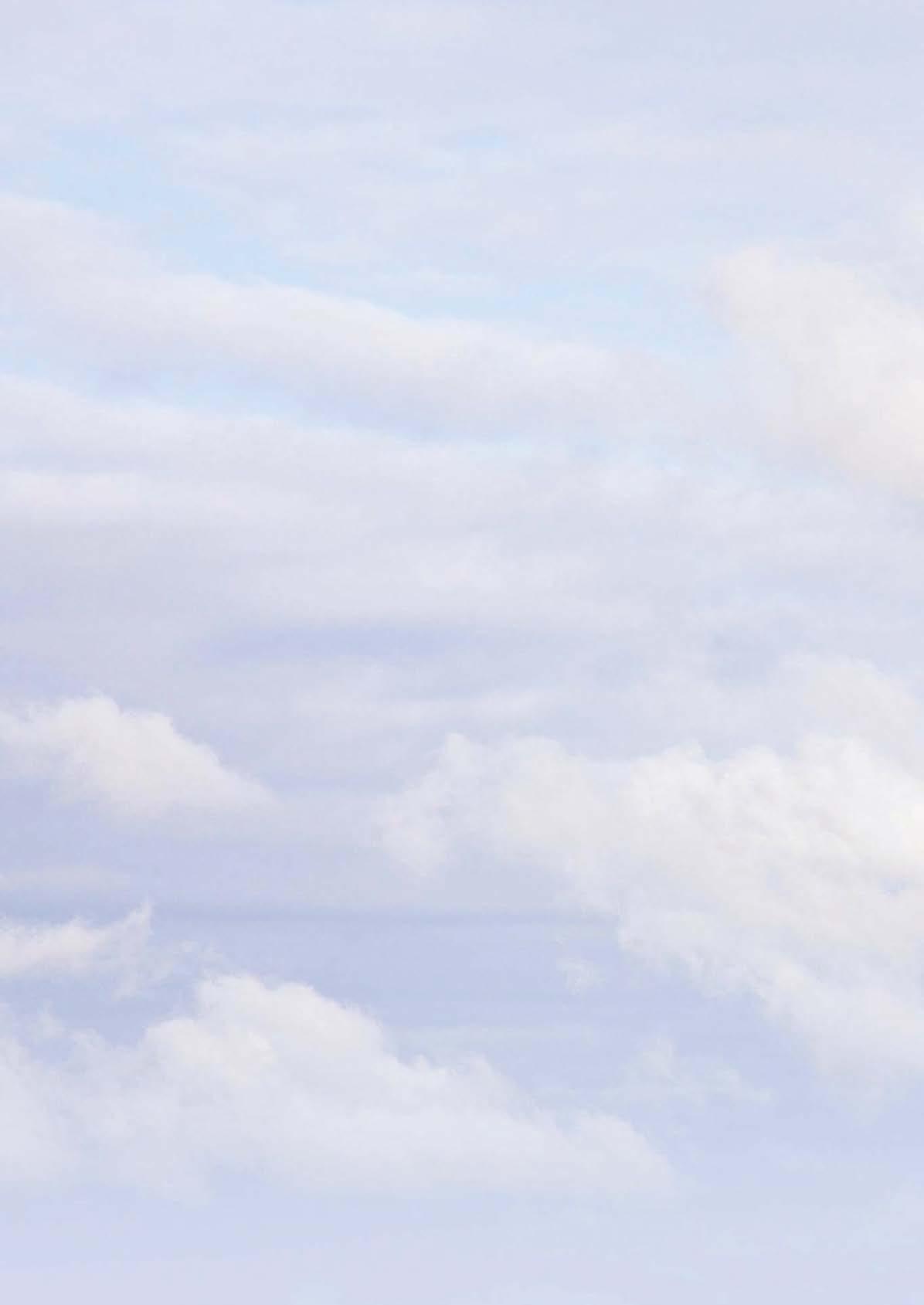
Can you raise £400 for 400 years?
Can you lead or be involved with one of the following?
Heriot's Summer Exhibition
AFormerPupil curlingevent?
Edinburgh Treasure Trail
Merry Month of Juneremix
AFormerPupil rugbyevent?
40 mile sponsored bike ride
AFormerPupil cricket event?
ride400milebike EdinburghtoLondon
20 Quadrangle
hockeyAFormerPupil event?
400km,
24-hour campus run Dress Georgelike parade
Film night under the stars
Spotthecoin competition
Bake a George competitionCake
AFormerPupil golfevent?
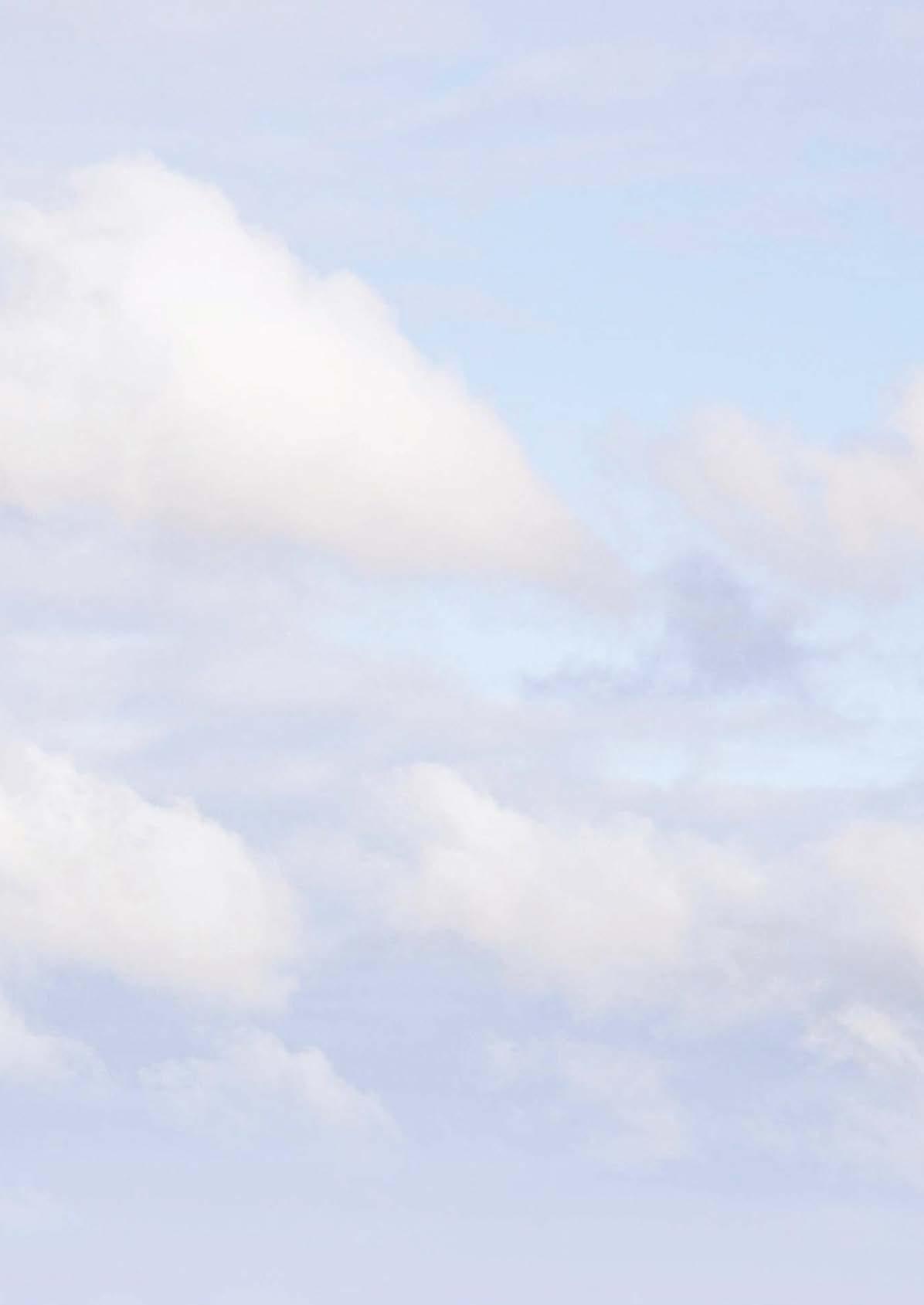
Can you volunteer to lead a fundraising project, either linked to the suggestions outlined or one of your own.
Come on Herioters, we can do this! We hope the wider Heriot’s community, together with pupils and staff, will raise enough money to fund at least one additional bursary place at Heriot’s.
Currently we have a head count of 1,675 pupils and 340 staff. If the majority
of us raise £50, we could support a bursary and change a young person’s life, with change to spare. So just think what we could raise with every parent and Former Pupil behind this cause too?
We would love you to get involved. If you would like to support a fundraising idea, have your own idea you would like to pursue, or if you would like to be a match donor, please do not
anglingAFormerPupil event?
hesitate to get onboard.
We will be launching a dedicated fundraising page for We are all George Heriot in Spring 2024. If you would like to receive a copy of our fundraising pack in advance or to talk to us about a fundraising idea, please email, or call the Development Team on dev@george-heriots. com or 0131 221 6716. i
Get involved! Contact the Development Team on 0131 221 6716
21
Lines go back to the Founder Fraser Simm
Our former school Archivist explores the Founder's possible London base and family connections.
In my piece for Quadrangle in Autumn 2021, I tried to trace and describe the life of the Founder in London. I was particularly keen to try to identify where he might have lived. Locating his house in Roehampton was relatively easy, but the best I could do for his other house in the Strand was somewhere on the north side of the street opposite one of the grand palaces that backed on to the river Thames. Job half done.
So, it was with considerable excitement that I came across a paper from 1875 detailing the references to George Heriot in the state papers of James I (and VI):
Amongst references to a note of the Queen’s debts owed to Mr Heriot, a warrant to pay “Geo. Herriot” and others £20,500 for jewels to be provided to the Queen and a warrant to pay £225 to “Geo. Herriot” for two diamond rings given to the Swedish Ambassador and other items, is an extract dated November 27, 1605
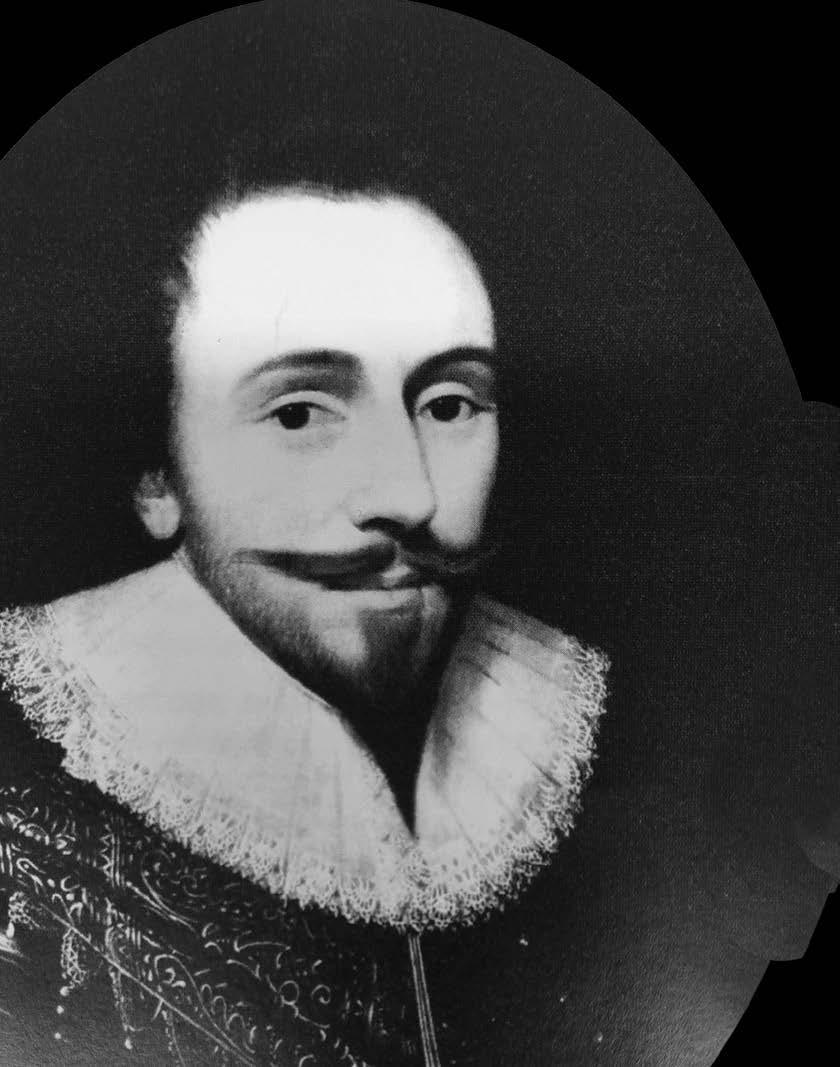
22 Quadrangle
“Examination of Nathaniel Torperley about his casting the King’s nativity for Mr Heriot, who lived at Essex House, the Earl of Northumberland’s”.
Right away I recognised that Essex House was one of the grand houses that lie between the Strand and the Thames; it had 42 bedrooms and a banqueting suite. This entry in the papers appeared to be clear evidence that I had stumbled on the location of George Heriot’s first residence in London. I congratulated myself on this find, but was a bit confused by the preamble in the extract, so I decided to look a bit further.
The date was a bit of a giveaway; 27 November 1605 was only 22 days after the Guy Fawkes attempt to assassinate King James and “casting the King’s nativity” meant telling the King’s horoscope or fortune. This did not sound like the George Heriot that we know about.
A further search identifies Nathaniel Torperley as a mathematician and astrologer who had connections to the Earl of Northumberland and to another mathematician and astronomer, Thomas Harriot. At this point it becomes clear that this reference in the state papers is not to George Heriot but to his namesake, above. Harriot was a remarkable person, who travelled with Walter Raleigh to America where he met two Native Americans, and from them translated their Algonquin language into English. Several years before Galileo he mapped the surface of the moon and, using a telescope, he was the first person to record sunspots. He also led the change to algebra using symbols rather than words and invented the symbols
for “greater than” > and “less than” < – a pretty formidable achievement in one life, but, alas, not the George Heriot I was looking for.
So, having climbed close to the top of the hill, I had to quickly return to where I started and to keep looking for any clues about George Heriot’s time in London. However, there is another story to tell that goes back close to Heriot’s life.
George Heriot’s famous bequest was to help children whose fathers had died (the Founder’s will referred to “Faitherless Bairns) but the Governors had to wait 36 years after Heriot’s death to put his wishes into practice. Looking back through the lens of near 400 years tells us much of this story, but a close reading of the records adds a most piquant angle. An extract from the Governors’ minutes of 13th November 1643 tells us: “Grants unto Robert and James Joussies, oyes (grandchild) to umquhile (deceased) George Heriot, the sum of ane thousand merks scots money to be paid yearlie be the Treasurer of the Hospital…and ordains the same sum to be paid yearlie to Elizabeth Heriot, Douchter natural to the said umquhile George and relict (widow) of James Joussie, for bringing up and entertaining of the saids tua children in meat, cloaths, boarding and utheris necessaries”
The two boys – Robert and James Jossie – were the Founder’s grandsons; their mother was Elizabeth Band who was born in 1613 and was one of Heriot’s two natural daughters. She inherited Heriot’s estate at Roehampton in London and changed her name to Elizabeth Heriot before she married James Jossie, who died in 1642, placing Elizabeth in difficult circumstances. References in the minutes continue through to 1649 and include payments for learning at Edinburgh’s High School, “winter suittis”, paper and ink. There is also a reference to a payment for “tyme of their seiknes of the pokkis (smallpox) and women to wait upone thame,” so clearly the Governors were doing their best for these two boys, and it is appropriate for Heriot’s two grandsons (who were certainly fatherless children) to be the first to benefit from the Foundation.
A few years on, in 1655, there is correspondence between Oliver Cromwell and the Governors in which the Lord Protector applies pressure on the Governors, instructing them to keep up the payment of pensions they had awarded to Elizabeth Jossie. The correspondence tells us that she had married again and was now Elizabeth Don. Payments were resumed but once the Hospital opened to pupils the Governors found their finances under pressure. In 1657, Governors also gave a yearly pension to two of the Founder’s nieces: Mary Kincaid and Grizel Ahanna, and supported George Scott, Heriot’s nephew, and his three children. No doubt, if Heriot’s had been open in those days, these members of the Founder’s family would have been admitted as pupils, but the story comes to a suitable conclusion with the admission of boys to the Foundation in 1659 when the Trust’s finances became wholly committed to running the Hospital. i

23 george-heriots.com
“George Heriot’s famous bequest was to help children whose fathers had died (the Founder’s Will referred to “Faitherless Bairns) but the Governors had to wait 36 years after Heriot’s death to put his wishes into practice.”
A Carefully Crafted Legacy
Speech by Hector McQueen
It always seems to surprise English and, indeed, Continental legal colleagues, when they find that Scotland has a law of trusts and a law of fiduciaries. This is because both are generally thought to be unique specialities of English law, exported around the world in the days of the British Empire, but unknown in countries where the law is based on Roman law - like those of the Continent and Scotland. So how did the trust get into Scotland?
My theory is that it is all down to George Heriot. We know the story: the successful Edinburgh goldsmith who in the 1590s was appointed jeweller to the Queen and then the King of Scots and became the moneylender who financed a lifestyle that was extravagant even before James VI succeeded to the throne of England in 1603 and moved to London. There the King and Queen were followed by their investment intermediary who flourished even more in London, while still retaining significant financial and landed interests in Scotland, especially Edinburgh. In the latter part of 1623, he – or rather, his Edinburgh lawyers – drew up two documents. The first was a disposition and assignation in favour of Edinburgh Town Council of the rental income flowing from a large number of lands in the Edinburgh area, to be used “to found and erect
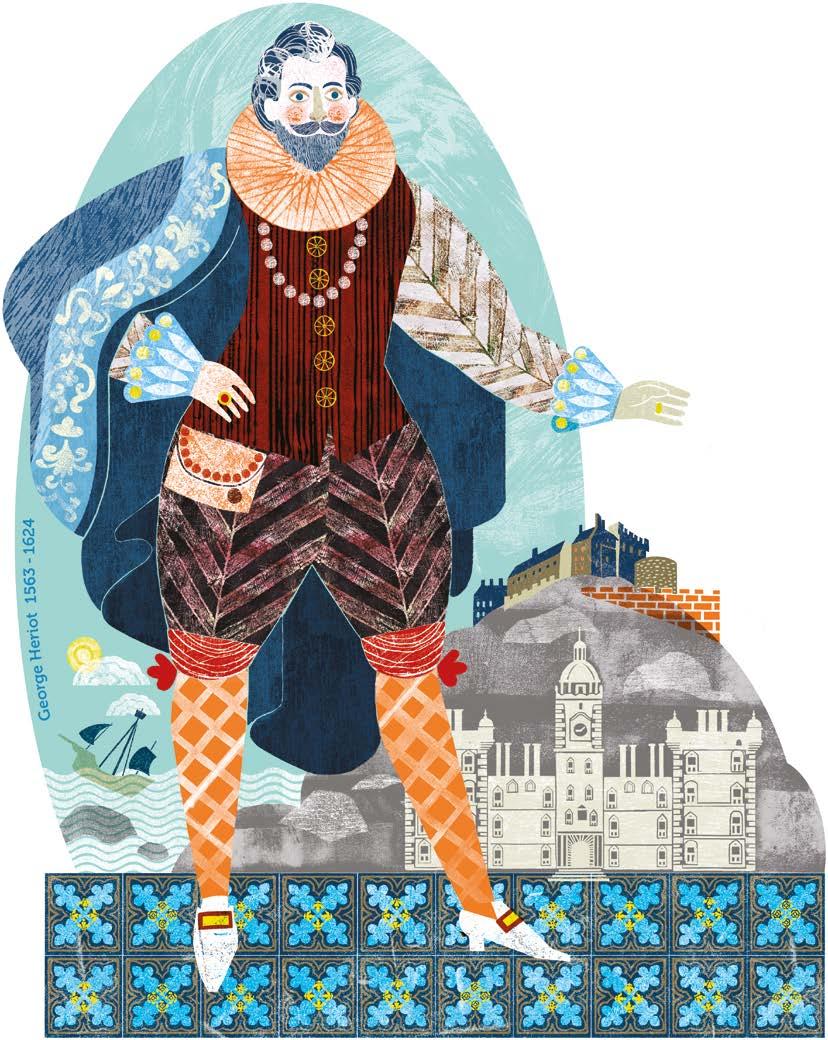
24 Quadrangle
ane publick, pios and charitable worke within the said Burgh of Edinburgh ... a Hospitall ... for educatione nursing and upbringing of Youth being puir Orphans and fatherles childrene of decayit Burgesses and freemen of the said Burgh destitut and left without meanes.” There was however also some provision for surviving members of his extended family – Heriot was a widower twice over, with no surviving legitimate children.
The second document was a last will and testament in which again he left various financial claims against his debtors to many named family members before finally bequeathing the residue of his estate to the Town Council “for and towardis the funding and erecting of ane hospitill within the said towne of Edinburgh ... for the mantinance relief bringing up and educatioune of so many puire fatherles bairnes friemens sones of that Towne of Edinburgh”.
These documents are obviously extremely well known, but I am not sure a proper analysis of their legal significance at the time Heriot had them drawn up has ever been made. There can be no doubt that what was established was a trust as we now understand it – Heriot the truster was setting property aside for a particular purpose and appointing trustees – the Town Council - to manage it according to his wishes for the benefit of the poor fatherless bairns, freemen’s sons in Edinburgh. But I think there is plenty of evidence in the elaborate content of the documents that Heriot’s Edinburgh lawyers were attempting something quite new in Scots law in 1623, a legal edifice that would be the same in effect as the model identified in Heriot’s disposition and assignation, Christ’s Hospital, founded by Royal Charter as a trust under English law in the 1550s.
The first thing to note is Heriot’s extended family, many of whom would have had inheritance claims on his vast estate. We know that in 1623 Heriot was taking legal advice about how to head these off; not because of any great family feud, but because he thought they were well enough off already, while he had to look after his immortal soul. (I do not say that, incidentally, in any cynical sense; I don’t doubt for a moment that Heriot
was a sincere Protestant Christian, but he would also have known that moneylending was not necessarily well-regarded in his faith.)
So it is significant that the documents make provision for that extended family but the first, the disposition, takes effect before Heriot’s death so that the property thus transferred is not part of his estate when he dies. As the disposition says, he is “Turnand and Transferrand fra me my aires and all utheris ... all right title of right clame Interest propertie and possessioun”.
The will, which of course is only effective after death, says that any legatee challenging the will thereby immediately forfeits their legacy, with the money then going to the Town Council. I don’t know how enforceable such a provision would have been in and around the early seventeenth century, but it is a serious sanction; even if the will was upheld after the challenge, the legacy would have been lost.
The trade-off for the family is that legacies are to be paid promptly and that family members are to be preferred should they ever fall on hard times and require the services of the Hospital. They are also given the role of Patrons in relation to the new institution which, as I will show in a moment, was by no means merely honorific. This is why I don’t think family feud or division has anything to with Heriot’s approach to the distribution of his estate after his death.
Another worry for Heriot was, of course, the Town Council itself, and whether it would carry out his wishes with regard to the erection of the Hospital once it had his money in its coffers. Indeed, his will refers to the possibility of “corruptioun in the Provost Bailzeis ... and Counsell”. The disposition says however that they are “To be my faithfull and most trustie fide-commissionaris and intrustit friendis” to carry out the “pios holie and religious uses” that he has in mind for his fortune, and that they are to be “dew and lawfull Administratours Directours Guyders Governours and Rewlers of the ... pios and publict Institutione”. As fellowChristians they could scarcely let him down after that!
But just in case there might notwithstanding be slippage on the part of the Town Council, Heriot also appoints formidable groups whose job is to ensure that his wishes are indeed carried out: the Archbishop of St Andrews, the Lord Chancellor, the King’s Treasurer, the Lord President of the Court of Session and the Lord Advocate; and, just in case the attention of these busy people strays too, “the Ministeris and ordinar preachours of the Burgh of Edinburgh [are to be] oversiearis inspectouris and visitouris”. The Patrons (the family, remember) also have a watching brief. Should the Town Council fail in the view of these people, then the whole scheme is to be void, and under the disposition the money is to revert to Heriot’s heirs male. Under the will, however, the money is to go to “the mentinence of sua manie puire scholleris in the universite of Sanctandrois in Scotland as salbe nominatt or appointit be Rectour and Proffessouris of that universite”.
As we know, the Town Council of the seventeenth century did not fail Heriot’s trust, although there would be quite a few vicissitudes before the Hospital finally opened in 1659, 35 years after Heriot’s death. And the University of St Andrews still awaits its scholarships, while I suspect that tracing Heriot’s heirs-male today would be a nearimpossible task. What I find significant, though, is the way in which Heriot felt he had to fortify his trust, suggesting that what he was doing had legally no precedent in Scotland, albeit there was clearly nothing unlawful about it. His lawyer told him that, despite views to the contrary from others, all had been done “according to the solid rewills of our law quhilk cannot be questionabill”. Heriot’s was not only the first Hospital of its kind in Scotland; it was also, I suggest, the first Scottish trust in the legal sense.
25 george-heriots.com
Extracted from Toast to the Pious Memory of the Founder, George Heriot, delivered on 5 June 2023. i
George Heriot: founder and Founder George Dalgleish, MA, FSA, FSAScot
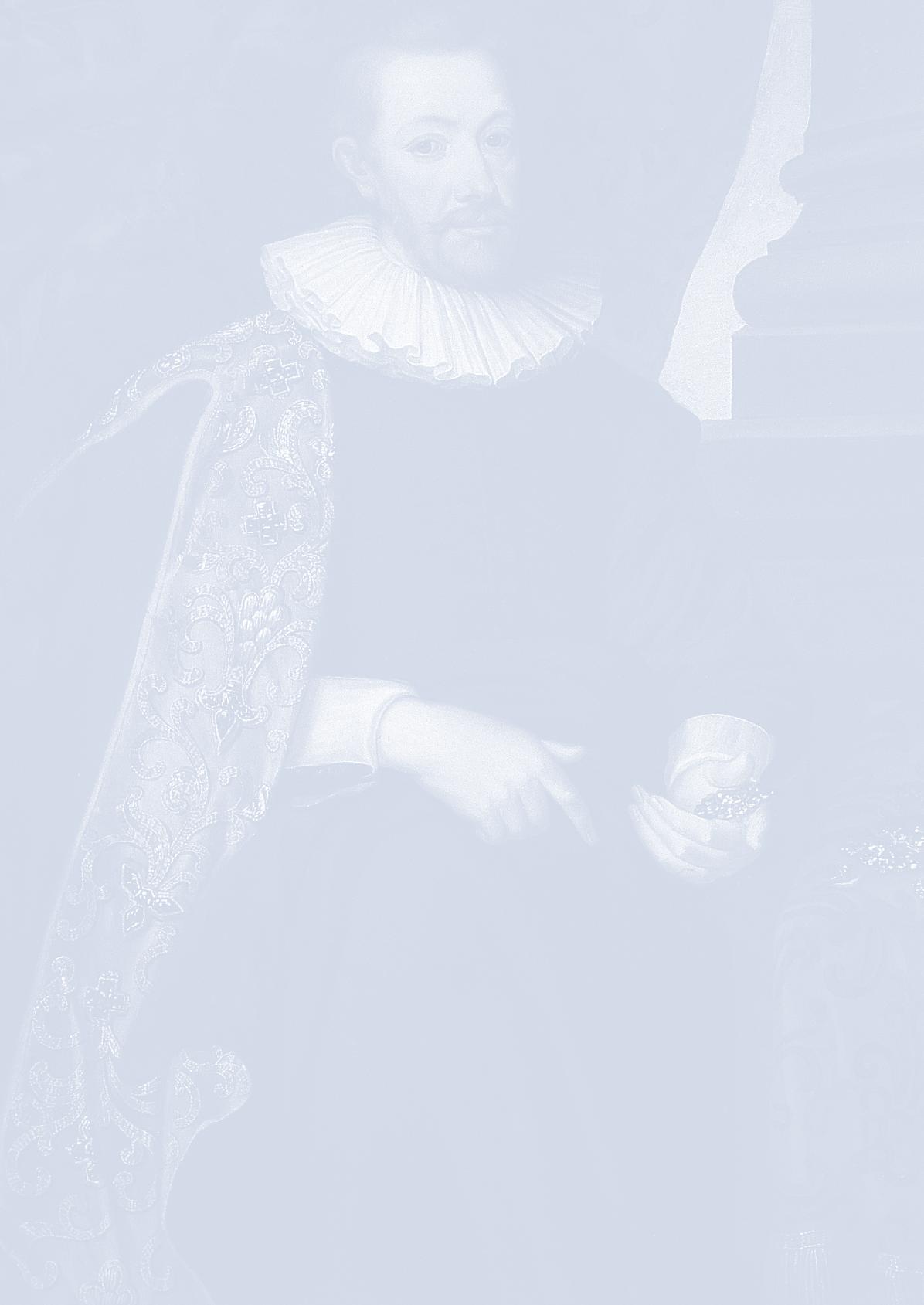
Four hundred years ago, on 12 February 1624 (or 1623 Old Style, as the year changed on 31 March at this time), George Heriot passed away at his home in the parish of St Martins in the Field, London.
Today, he is rightly remembered either as the Founder of this School, or as ‘Jinglin’ Geordie,’ banker and money lender to King James VI & I. Sir Walter Scott is responsible for this well-known nickname, which first makes its appearance in his novel The Fortunes of Nigel, published in 1822. Scott emphasised Heriot’s role as a canny and successful, yet upright and honest Scots businessman, a beacon of probity in the ofttimes murky world of the Jacobean Court. So, founder or banker? While both these characterisations are true, they possibly overlook a more fundamental identity that also applied to George. He was, first and foremost, a goldsmith. A talented and successful craftsman, whose ultimate fortune (the original lifeblood of his foundation of the school) derived from his ability to make and sell soughtafter wares of gold, silver, and jewellery.
So, it might be interesting to look at George Heriot the goldsmith, and what he made and sold to his clients in Edinburgh and London. Sadly, we come up against a fundamental problem: there is not a single surviving piece of jewellery or plate bearing his maker’s
mark! Considering the vast amount of jewellery and plate that we know he sold to King James, Queen Anne, other members of the Royal family and numerous wealthy patrons, this scarcity is deeply unfortunate, although perhaps not surprising. It is possibly this lack of surviving pieces that has given rise to the suggestion that he wasn’t really a working goldsmith, and was, rather, a money man! A brief look at his life and early career will hopefully dispel this notion.
Like many Edinburgh goldsmiths, George was born into a well-established dynasty of craftsmen, members of the prestigious Incorporation of Goldsmiths, which governed all aspects of the
craft. His father and grandfather, also Georges, were both freemen of the Incorporation and thus had the right to ply their trade in the burgh. Membership was a privilege but came with strict requirements, including serving a 7-year apprenticeship to an established master; working for three years as a journeyman; having sufficient funds to pay a hefty joining fee and being of ‘guid life and conversatioun’! Our George was apprenticed to his own father (a very successful and well-respected craftsman,) and was admitted a freeman in his own right on 28 May 1588, having fulfilled all that was required of him. This included the usual practical test of skill, or ‘essay
26 Quadrangle
“Our George was apprenticed to his own father and was admitted a freeman in his own right on 28 May 1588, having fulfilled all that was required of him”
piece,’ which was judged by the other masters to be ‘sufficiently wrocht’ (well made)! Unfortunately, we don’t know exactly what young George was asked to make, but it would normally have included a gem-set ring and a piece of holloware such as a cup. (George’s father’s monument in Greyfriars Churchyard is carved with a good representation of such a ring. The monument was commissioned and paid for by our George and his brother when their father died in 1610). Somewhat unusually, George had already been set up in business two years before he became a freeman. On his marriage to Christian Marjoribanks in 1586 his father provided him up with a booth, or workshop, beside the High Kirk of St Giles, gave him considerable working capital and supplied him with all the necessary tools of the trade or ‘werk loomis’. This was a very significant ‘start -up’ package for the young George.
On becoming a freeman, he was also permitted to take on his own apprentices and journeymen to advance his business, provided he could properly train and accommodate them. He seems to have taken on at least five or six apprentices while working in Edinburgh, all of which suggests he was a practising craftsman. His skill was such that, in 1597, he was appointed as goldsmith and jeweller to Queen Anne and four years later as jeweller to the King, James VI. These appointments were for life.
The scale of his work for the Royal Court is evident from the voluminous series of accounts, bills and inventories that still survive both in the Heriot Trust papers now held in the National Records of Scotland (GD/421), and in the National Archives, Kew (LR2). In 1599, for example, he was ordered by the King to produce a ‘cupboard of plate’ as an ambassadorial gift to Monsieur Vetonu, the French Ambassador. This was a very significant commission of lavish ceremonial silver-gilt plate for the banqueting table, including two basins and ewers, two flagons, two chandeliers (probably candlesticks), six covered cups, two other cups, a water jug and a salt cellar, all highly decorated with elaborate chasing and engraved with armorials, amounting to some 773 ounces of silver
(for comparison the Heriot Loving cup weighs just over 17 ounces, see below).
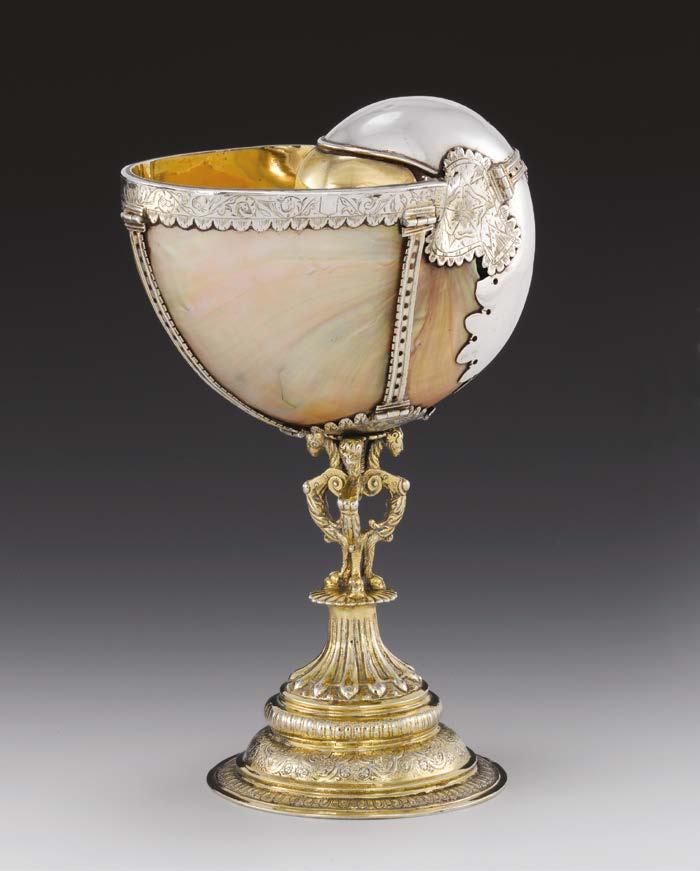
Sadly, nothing of this has survived, but one can get an idea of what it was like by taking a close look at the decoration of the ground floor windows on the north façade of the school, where you will find representations of just these sorts of basins, ewers, and covered cups!
So, what does survive that has a strong connection with Heriot? The most obvious and well-known piece is, of course, the Heriot Loving Cup, long preserved by the School, still present at the annual Founders Dinner and now on loan and on display in the National Museum of Scotland. When it was presented to the school in 1792 by Mr John Stewart, it was thought to have been
made by Heriot himself.
Certainly, it is the work of a master craftsman and is a unique survivor in Scotland. It is made from a very fragile Nautilus shell, held in silver gilt strap mounts on a highly decorative stepped foot. The mounting of then rare and exotic shells, nuts and eggs was a common practice in the early 17th century, but few have survived in Scotland. Sadly, recent scholarship has proved that it is not the work of Heriot, but rather that of a contemporary of his, Robert Dennistoun. Made in Edinburgh in 1611-13, it has the marks of Dennistoun and David Palmer, the Deacon, or leader of the Incorporation, who tested and authenticated the quality of the metal used in the work. Palmer was also a
27 george-heriots.com
Heriot's Loving Cup
contemporary of Heriot, having been apprenticed to his father, George senior. Although not made by George junior, it is more than likely that it did belong to him, as a ‘Loving Cup’ is recorded in one of his inventories and the cup is engraved, very faintly, with the initials ‘GH’!
Another example of historical wishful thinking relating to the elusive maker’s mark of George Heriot, was discovered in a house in Irvine, Ayrshire in the early 19th century. This was a group of seven disc-end spoons, engraved with initials indicating that they had belonged to Alexander Cunningham, son of the 4th Earl of Glencairn, and his wife Jean Blair. As they are clearly stamped with a ‘GH’ maker’s mark, it was hoped they were the work of ‘our’ George. Again, however, recent scholarship has proved that they were in fact made by his father, George Heriot senior, circa 1582. As such, they are the only known surviving examples of his work; however, it is just possible
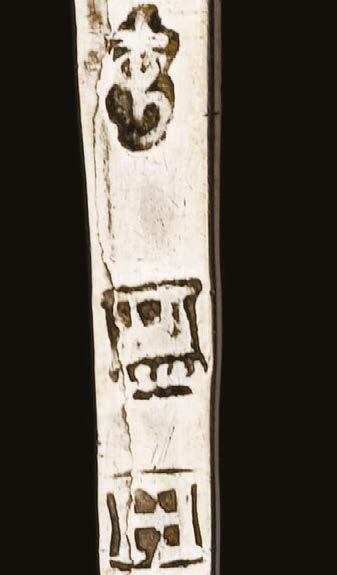
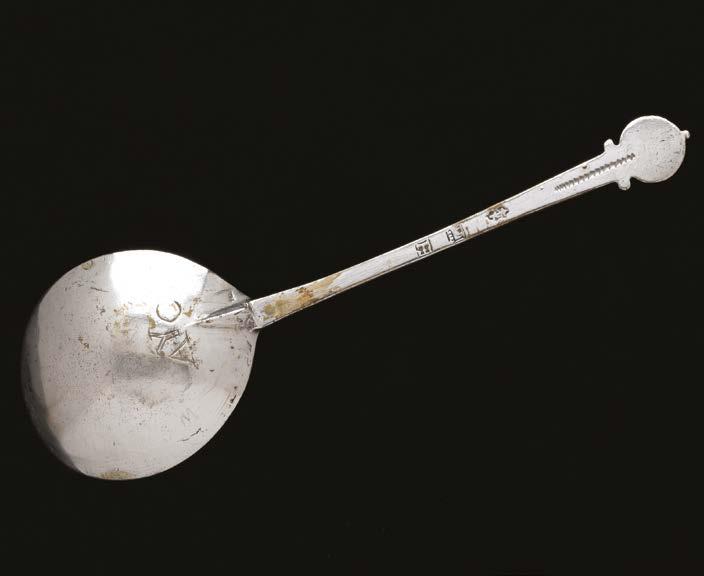
that his son may have had a connection with them. In 1582, George junior would have been an apprentice in his father’s workshop. In any busy workshop at that time apprentices with sufficient training and skill were expected to take a hand in the production of the wares on order, especially relatively simple pieces. So, it is entirely possible that George Heriot junior did have a hand in making these spoons. Again, they can be seen on display in the National Museum of Scotland.
Before talking about George’s lucrative career in London, it might be worth explaining just why surviving gold and silver vessels and jewellery from this period are so rare. The answer is simple, gold, and silver are the original ‘green’ materials. They can be endlessly melted down and re-made into something new. This, coupled with their intrinsic value and the demands of wealthy customers for the most current fashions in jewellery and plate, ensured that ‘old’ pieces were
1 of 7 disc-ended spoons discovered in a house in Ayrshire
28 Quadrangle
“Gold, and silver are the original ‘green’ materials. They can be endlessly melted down and re-made into something new.”
constantly being broken up, and the metals melted down and jewels re-cut and re-set into shiny, new, up-to-date pieces!
Not long after Heriot had been appointed as Royal Goldsmith and Jeweller for life in Scotland, England’s Queen Elizabeth I fell ill and died. James VI, as her nearest legal heir, became James I of England on 24 March 1603. He and Queen Anne travelled south immediately to take up the crowns of what James hoped would become the United Kingdom of Great Britain. Many members of the Scottish Royal Court followed them to London, including craftsmen such as Heriot, alive to the expanding prospects in a kingdom immeasurably wealthier than the one they were leaving.
During his time in London, Heriot’s business grew exponentially. Queen Anne was undoubtedly his best customer, and we know from surviving bills and accounts that he supplied her with hundreds of jewels, including rings, necklaces, earrings and, importantly, jewelled cases, or ‘tablets,’ for miniature portraits. While Anne was indisputably fond of highly fashionable jewels for herself, many of those supplied by Heriot were for gifts to others. Costly gifts were part of royal diplomacy, which helped bind supporters to the Stuarts. This was also true for Heriot’s other Royal customers such as the King, his sons Prince Henry and then Prince Charles.
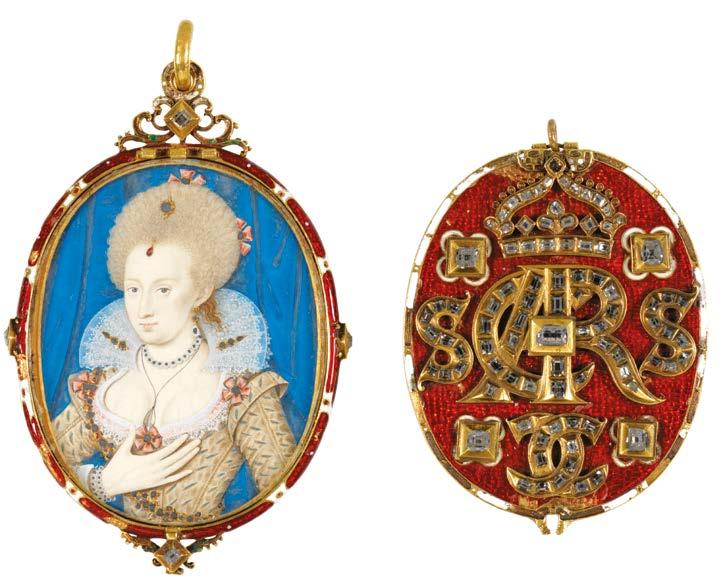
His importance to the court was further cemented by his ability to act as what is now described as a ‘credit creator;’ he advanced loans of liquid cash in return for important jewels being pawned to him. This was a lucrative but risky business, especially as the Royal Stuarts were notoriously tardy at paying their dues. (After his death, Heriot’s executors spent many years trying to recover debts owed to his estate, something that slowed down the full realisation of his scheme for this hospital for Edinburgh orphans… but that is another story!) Heriot’s financial activities, however, cannot really be called banking in the modern sense. He did not, for example, take in deposits, issue cheques or many of the other facilities offered by a bank. They did, however, contribute to his eventual fortune.
 Sketches on the reverse of a 1606 to Queen Anne, perhaps evidence of jewellery designed by George Heriot?
Sketches on the reverse of a 1606 to Queen Anne, perhaps evidence of jewellery designed by George Heriot?
29 george-heriots.com
Anna of Denmark: the Eglington Jewel, a rare survivor Copyright Fitzwilliam Museum
Considering the scale of what was produced by his workshop, it is sad that no marked pieces survive. However, here are two pieces still in existence that we can be certain he created. The first is now known as the Eglinton Jewel, a beautiful example of a ‘tablet’ - a type of jewel that was particularly fashionable at the turn of the 16th/17th century. It is one of the best documented pieces of early 17th century jewellery in existence. Its gold frame contains a miniature of Queen Anne. The front is decorated with red enamel and the initials ‘CAR’ picked out in diamonds. This was Anne’s own personal cypher, for Anna Regina and C for Christian, her beloved brother, the King of Denmark. Not only does it appear in a bill from Heriot in 1610, but it is also faithfully depicted in a portrait of Lady Anne Livingston, painted in 1612, to mark her wedding to Sir Alexander Seton, later 6th Earl of Eglinton. Indeed, the jewel may have been given to Lady Anne as a wedding present by the Queen after whom she was named. But perhaps the most exciting and unusual piece of evidence for the jewel comes from another Heriot document. On the back of an itemised
account of jewels supplied to the Queen in 1606, are some rough pencil drawings. These can only be preliminary sketches for the design of this jewel, the ‘back of an envelope’ diagrams by the goldsmith, hastily drawn on the nearest piece of paper snatched from his bench, in response to a verbal request for the jewel. Surely a remarkably personal link to the talented creator of this jewel – George Heriot!
Based on the style and evidence for the Eglinton Jewel, we can now say, with some certainty, that another surviving ‘tablet’ jewel was also made by Heriot. This is known as the Lyte Jewel. It too contains a miniature portrait, this time of King James himself, painted by Nicholas Hilliard, within an openwork frame, set with diamonds picking out the royal monogram ‘IR,’ for ‘Iacobus Rex.’
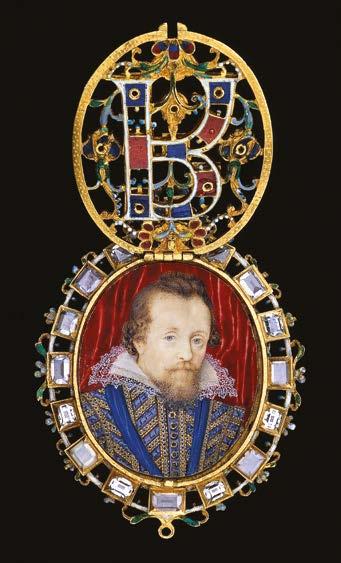
It was presented by the King, between 1610 and 1611, to Thomas Lyte of Lytes Cary in Somerset as a mark of royal thanks and favour. Lyte was a genealogist and antiquarian. He had created and gifted to James an extensive and highly illustrated Royal genealogy, a pedigree of British monarchs tracing James’s descent back to the mythical founder of Britain, the Trojan prince Brute! At the time, such genealogies (no matter how mythical) were important political documents, supporting the legitimacy of the Stuart monarchy that had so recently acceded to the throne of England and playing a part in fashioning a
history of the newly united (in James’s eyes anyway) Kingdom of Great Britain. Like the Eglinton Jewel, Lyte was so pleased with his gift that he had his portrait painted wearing it. Both the Eglinton and Lyte jewels show Heriot at the height of his creative powers as a working goldsmith.
George Heriot’s legacy to his native city obviously came in large part from his role as credit creator and money supplier to the Court. But this, in turn, could only have happened because he had the financial wherewithal and liquid funds available to advance in this way. These funds were the product of his primary business as a talented and goldsmith/jeweller.
If one looks at the first and, I will argue most important of the unique group of narrative carved panels immediately above the entrance to his greatest creation, the school, this becomes clear. It shows George in his workshop or booth, dressed as a working goldsmith, with his bench and tools of the trade, blowing the bellows of a forge where he is smelting precious metals for casting, or ‘founding,’ to make jewellery and vessels for sale to his customers. The Latin motto reads ‘Fundendo Fundavi’ or ‘By founding I have Founded.’ The artists and designers who created this marvellous work were in no doubt where Heriot’s wealth originated. His talent and acumen as a goldsmith indeed allowed the founder to become The Founder. i
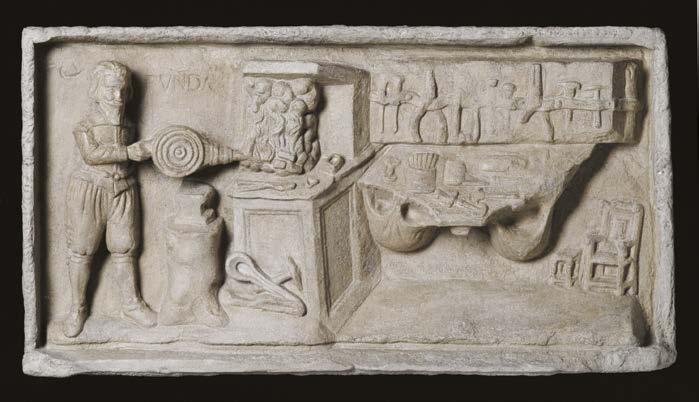 The Lyte Jewel: portrait of King James VI of Scotland and I of England. Copyright British Museum.
The Lyte Jewel: portrait of King James VI of Scotland and I of England. Copyright British Museum.
30 Quadrangle
Carved panel as can be found in entering the school, depicting George Heriot 'founding.'
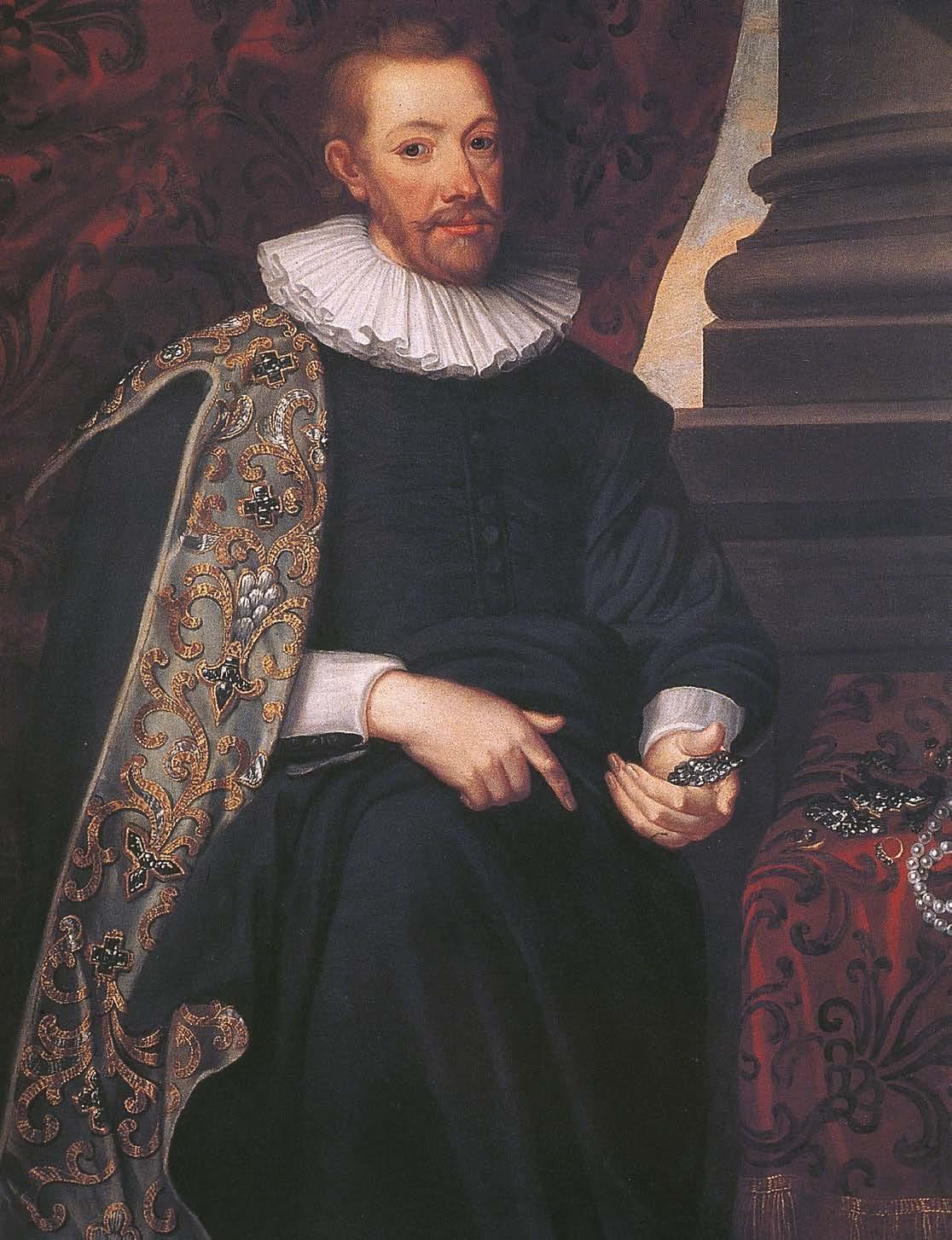
31 george-heriots.com
One Hundred Years at Heriot’s
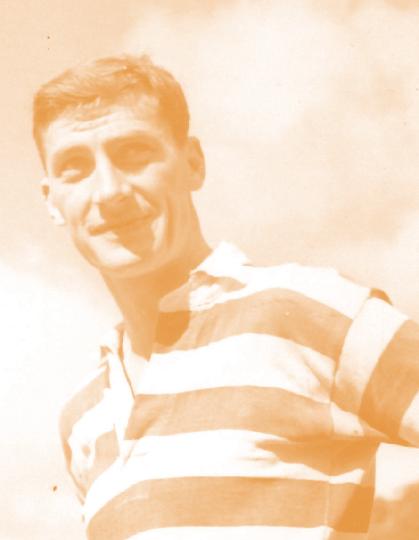
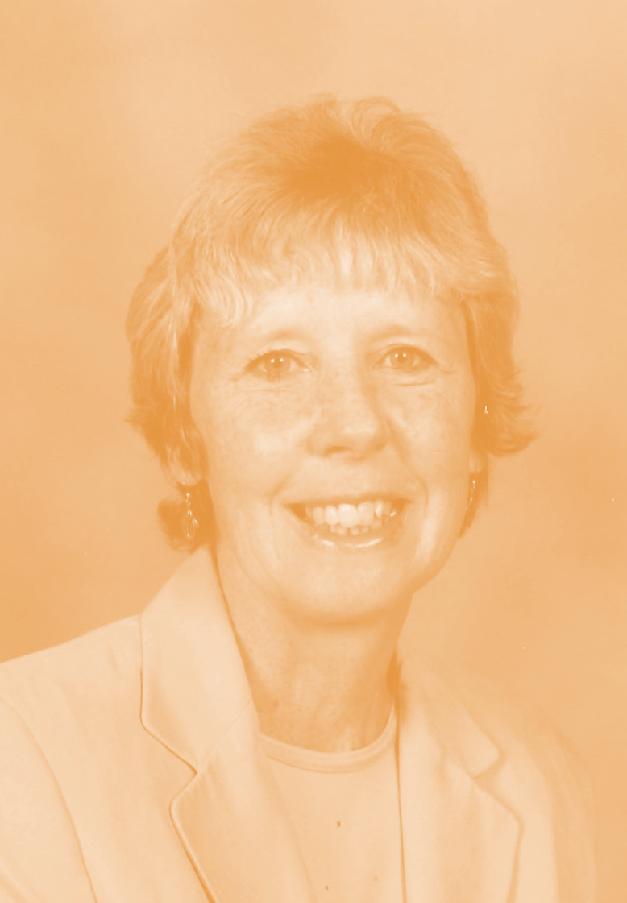
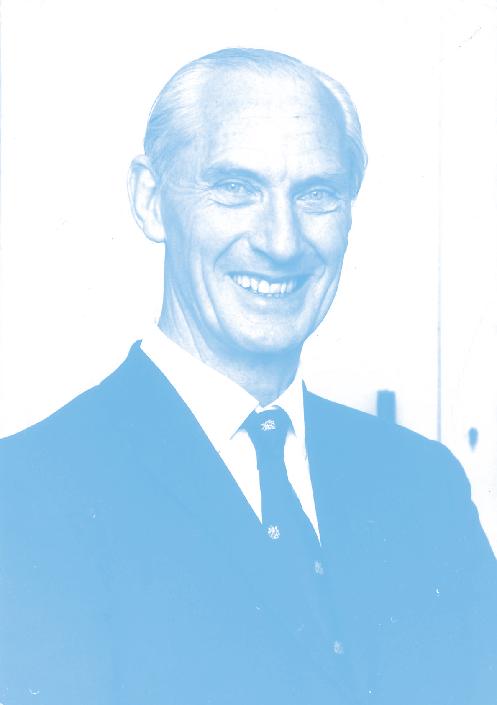
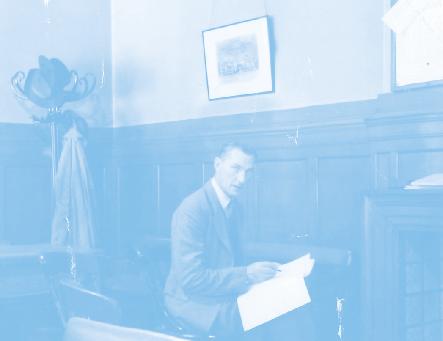 By Ruth Armet
Clockwise from above: Mrs Ruth Armet, Junior School Teacher, retired 2010.
By Ruth Armet
Clockwise from above: Mrs Ruth Armet, Junior School Teacher, retired 2010.
32 Quadrangle
Mr Galloway, retired from Teaching English & History at George Heriot's in 1975. Mr TG 'Gibby' Galloway (1929).
Mrs Ruth Armet recently contacted the Development Office to share her family’s story and involvement with the school spanning over 100 years. In her own words she describes the timeline of her various family members who have graced the halls of George Heriot’s School.
“My late father, TG ‘Gibby’ Galloway, enrolled as a pupil at George Heriot’s on 26 September 1922 and so began a family connection with the school spanning over a century.
On leaving school in 1929 Gibby completed a degree in English at Edinburgh University followed by teacher training at Moray House. It was not long before he was back at Heriot’s appointed teacher of English and History in 1936/7. Apart from war service between 1941 and 1945 he remained at Heriot’s serving as head of the Junior School and laterally as Deputy Headmaster until his retiral in 1975.
As children my sister Anne and I grew up surrounded by Heriot families; well-known Former Pupil names of the times including Blamire, Lawrie, MacDougall, Ogilvie, Oxley, Waitt, Weston and Williams as well as staff and their families – Connell, Hunter, Park, Stott and of course Miss Simpson.
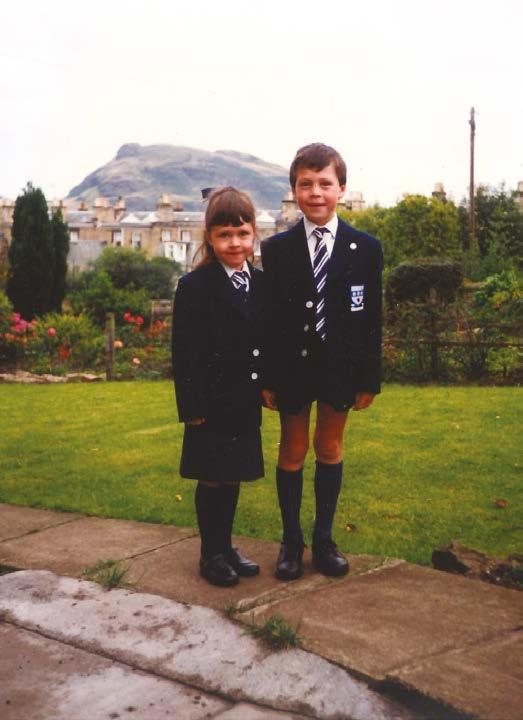
Had Heriot’s been co-educational I have no doubt that my sister Anne and I would have been Heriot girls. It was not always an advantage to have a well-known teacher as a father – not all members of the opposite sex were prepared to run the gauntlet when the family name and connection was divulged!
No matter where my parents travelled my father would, without fail, meet a Herioter – enjoying hospitality from Former Pupils and school friends as far afield as Australia and New Zealand and reciprocating when such friends revisited Scotland. After retirement, ties remained as strong as ever and our family home at Macdowall Road, continued to welcome those with Heriot connections throughout my parents’ lives.
By the time my father retired, my sister, was also now a member of staff. Miss Galloway was appointed in 1973 as a teacher in the Prep, as it was then known back then, teaching a class of 36 small boys. She remained at Heriot’s
until she married in 1977 and moved to Aberdeen.
Meanwhile, I married a Herioter and my two children attended the school, Neil from 1986 to 1999 and Carolyn from 1988 to 2001. By 1989 I had been appointed to the Junior School staff and spent the remainder of my career there, following the family tradition. By the time I retired in 2010, my daughter Carolyn was a member of staff having qualified as an Early Years Practitioner.
Teaching seems to be in our blood. My son and his wife are teachers in Glasgow. My daughter met her husband, a fellow teacher at Heriot’s, they even welcomed the Junior School Choir to sing at their wedding. Now in 2023, she is moving on to further her career in Midlothian.
Gibby would no doubt have been amazed but also delighted that one hundred years on from his enrolment at Heriot’s there would still be a Galloway at the school.
However, as they say, all good things must come to an end… for now! There may be a Galloway back at Heriot’s in the next 100 years!” i
For Issue 44 of Quadrangle, we would like to feature more ‘generational Herioters,’ if you would like to share your family ties with the Heriot’s community, please do get in touch. We love to hear stories on how the school has shaped so many families over the decades.
You can contact the Development Team at dev@george-heriots.com
33 george-heriots.com
Third generation Herioter, Neil (1999) & Carolyn (2001)
Alexander Kirkwood & Sons Casting a Legacy
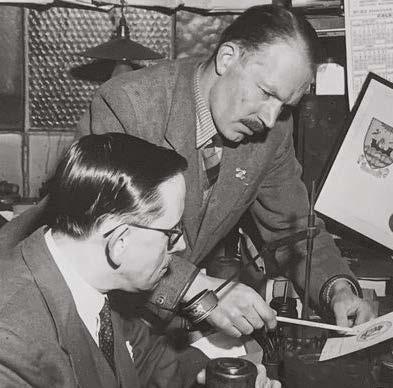
Alexander Kirkwood and Sons has a long and established history in Edinburgh and with George Heriot’s. In 1774, James Kirkwood’s hand engravings were noticed by Sir William Forbes, head of an Edinburgh Bank. James was commissioned to produce metal plates for the banknotes of the Union Bank of Scotland. A history of craftsmanship and entrepreneurship are clearly in the Kirkwoods’ blood as subsequent heirs took on the mantle of the business. The most recent leaders David, (happily retired) and his daughter Alison, display the same skills, dedication, creativity, and aptitude in leading the family business as their forbears.
Over the years Kirkwoods has been renowned for quality of craftsmanship, most famously for casting the dye and seal for the ‘Great Seal of Scotland’ for George VI, used to confer royal assent to official documents during his reign. Kirkwoods is proud to have created the prestigious ’Livingston Medal,’ conferred upon luminaries such as Sir Edmund Hilary, Sir Ranulph Fiennes and Sir David Attenborough in recognition of ‘outstanding public service […] to the
34 Quadrangle
benefit of the Human Race.’
Kirkwoods has longstanding relationships with many esteemed institutions, from Scottish Tennis to The Royal Highland & Agricultural Society of Scotland, to St Andrews Links Trust and the Royal Portrush Golf Club, the latter holding fond childhood memories for David Kirkwood and his family as they caravanned across Ireland. While his sons played a round of gold, David’s enjoyed a few whiskies with Sir Anthony Babington, who in turn invited David to create a design for the Club’s medal.
Kirkwood’s has been supplying that same medal, struck from a steel die, designed by David since the 1950’s. It features the fifth green in the foreground and the ruins of Dunluce Castle behind.
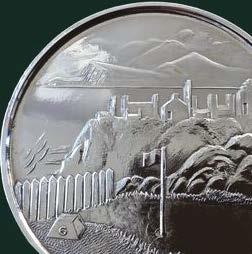
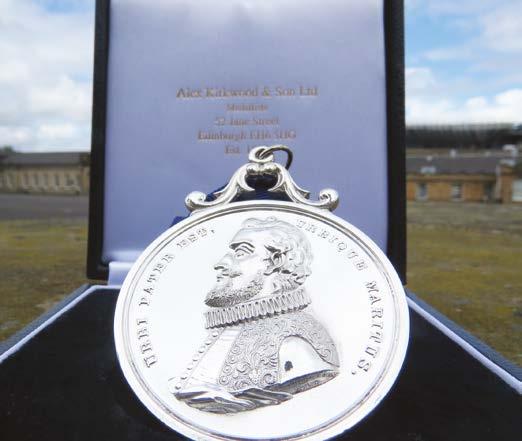
The deep connection to Heriot’s is important to the school and David, as a Former Pupil, the youngest brother of three and son of a Herioter, holds this personal relationship dearly. As a business, Alexander Kirkwood & Sons produces many medals for the school, such as the Dux medal stamped with a magnificent bust of George Heriot, also a beautiful medallion that is presented to each
Foundation pupil as they leave George Heriot’s. Of significance, Kirkwoods also cut and cast the 100-year-old President’s medal passed every two years from the outgoing Herioter President, to the incoming, a precious piece of living history.
With Kirkwood’s part in the history of Heriot’s across four generations, we thought it was important to meet with David Kirkwood and hear his thoughts on this historic connection.
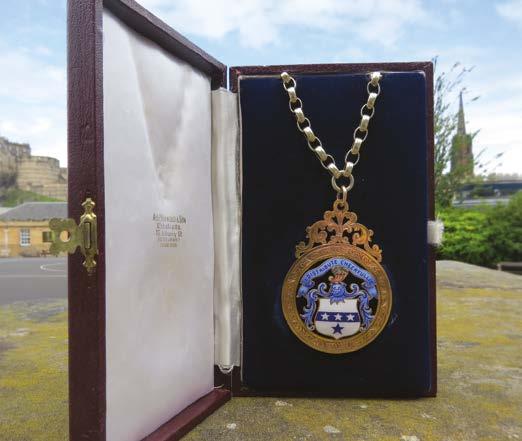 Herioter President medal The Dux medal
Herioter President medal The Dux medal
35 george-heriots.com
Medal cast for Royal Portrush Golf Club, by Kirkwoods, depicting the 5th green and the ruins of Dunluce Castle, Co. Antrim.
David Kirkwood (1963)
(pictured below) In his own words
David, tell us about your role in the family business?
Until a couple of years ago, I managed my family business, Alexander Kirkwood & Son, one of the oldest family-run businesses in Scotland, founded in 1826. It’s Scotland’s sole surviving specialist medallist; we are also a silversmith, trophy maker and engraver, producing items for some of the most prestigious organisations in the world.
How did you come to the family business?
At fifteen years of age, I was sitting in an English class one afternoon under the tutelage of Mr Heron (affectionately known as ‘Kipper’) and a message came that I was to visit the headmaster’s office. After knocking on the headmaster’s door, I entered to discover my father sitting alongside Headmaster Mr William Dewar, which was quite a shock. It was explained to me that as the youngest son, I was to leave Heriot’s and immediately join the family business!
So, I left school earlier than my contemporaries and started working in the
family business. It’s difficult to say if I had a choice in the matter, as a fifteen-year-old, faced with a suggestion from your father and Headmaster, there’s probably only one answer that you give.
Joining the family business was a path to lead the company and continue the heritage of this historic business. I spent many early years learning the trade, working for my father, and later learning the craft, I attended art college in the evenings, learning the art of lettering and silversmithing.
My journey took me from apprentice engraver to medallist. I didn’t walk into management, I worked hard to learn the craft for many years before taking over the business from my father. That has always been invaluable experience.
What achievements are you most proud of?
From a personal perspective, I’m proud of my three daughters with my wife, Gillian, of over 50 years, who have all gone on to have successful careers. I’m also a proud grandfather of 8 wonderful grandchildren – the youngest is now 9 and the eldest 17.
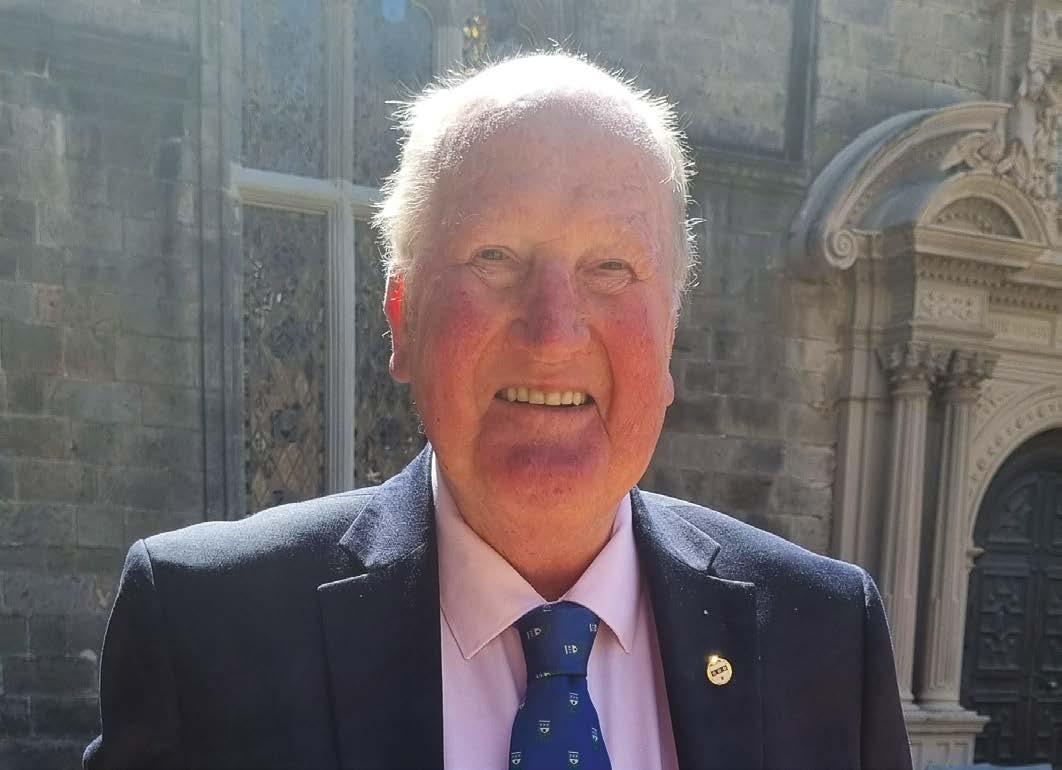
From a professional standpoint, I’m
delighted that I have managed to continue the specialist craft of medal making in Scotland and been able to play my part in the continuation of a business that has such a deep history and heritage. I’m delighted that my youngest daughter, Alison, has taken over leadership of the firm, meaning that its future remains in the sixth generation of our family.
Do you have a favourite commission?
We have made some magnificent medals and bespoke silverware over the years.
We made a bespoke sterling silver replica hickory golf clubs for Atlanta Athletic Club in America. These pieces are magnificently handcrafted with intricate, detailed engraving. The silver clubs are then adorned with bespoke replica silver golf balls, each golf ball representing one of the presidents of Atlanta Athletic Club. A singular gold golf ball represents the presidency of the late and great, Bobby Jones, arguably the greatest golfer of all time.
We have produced stunning medals for many different organisations including the Royal Scottish Academy, Royal Society of Edinburgh, and the Royal Highland
36 Quadrangle
Agricultural Society of Scotland. The latter is possibly our longest-standing client. We are also proud to produce the medals for George Heriot’s including the beautiful Dux medals featuring the bust of George Heriot on the front.
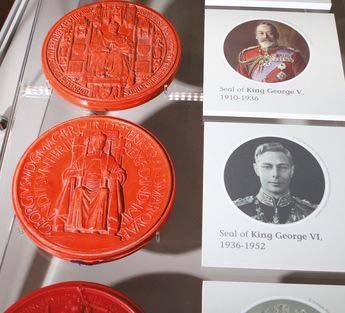
What is your favourite memory about running the business?
I have had the great privilege through my work at Alexander Kirkwood & Son of meeting hundreds of different people from all walks of life. That has been fascinating and enjoyable.
I grew up playing golf and developed my own love of the game. I’m fortunate that Alexander Kirkwood & Son has always had a strong heritage in golf medals and so I have been able to combine my personal interest in the game with a professional cross-over. Today, a significant part of our business is linked to golf.
Fondest memories of George Heriot’s School?
I was only at Heriot’s for a short time – about 4 years, but those 4 years were very memorable! I wasn’t the most academic of pupils, my passions were in sport and practical subjects such as woodwork. My memories are more on the extra-curricular side! I had a ‘mini business’ selling frog spawn in jam jars in the playground which I collected and brought into school from ponds out near Lasswade. I enjoyed playing football matches with a tennis ball in the playground. The journey home was always an adventure – school finished at 3:10pm and I had to make the 3.23pm train to Bonnyrigg, so remember running down the Scotsman steps 5 at a time! I was a keen train spotter (in those days, trains were wonderful!) so missing the train wasn’t a great disaster.
I have a fondness for the friendships I developed at school. I used to play games of hangman with John Ellis (at times when we were supposed to focus on class subjects!) who later, like me, would become a Gullane Golf Club member.
Whilst my career has been fulfilling, I missed out on 3 final years at Heriot’s, I would have appreciated the chance to spend that time at school, and on the rugby pitch.
Do you recall a favourite teacher?
I have many fond memories of
teachers who left an impression – from Mr McPhee (nicknamed ‘Huck’ McPhee), who taught mathematics, to Tony Welton, who taught physical education.
How important is George Heriot’s motto, to ‘Distribute Chearfullie’?
My father, himself a ‘Herioter,’ set a fine example in terms of ‘Distributing Chearfullie.’ He was a strong member of the Rotary Club of Edinburgh for decades and received a ‘Paul Harris Fellow Award’ for his contribution. I followed in my father’s footsteps and joined the Rotary Club of Edinburgh too. That sense of contributing to wider society is instilled
from my time at Heriot’s. ‘Distribute Chearfullie,’ always with a smile!
What values did you take from Heriots?
I developed a reputation as an afterdinner speaker and began being invited to an increasing number of events. Over my lifetime, my after-dinner speaking has taken me the length and breadth of the UK, as well as to the likes of Ireland and across to the United States, delivering speeches, especially at golf events.
On reflection, the confidence that is required to become a sought-after speaker, undoubtedly came from my time at Heriot’s. i
37 george-heriots.com
Over the years, Kirkwoods has been renowned for quality and craftsmanship, most famously for casting the die and seal for the Great Seal of Scotland for George VI.
Could you walk in George Heriot's footsteps? Leaving a legacy in your Will
A gift in your Will is a powerful way of supporting George Heriot’s Foundation and offers a lasting legacy that will impact the lives of young people yet to walk through the gates on Lauriston Place.
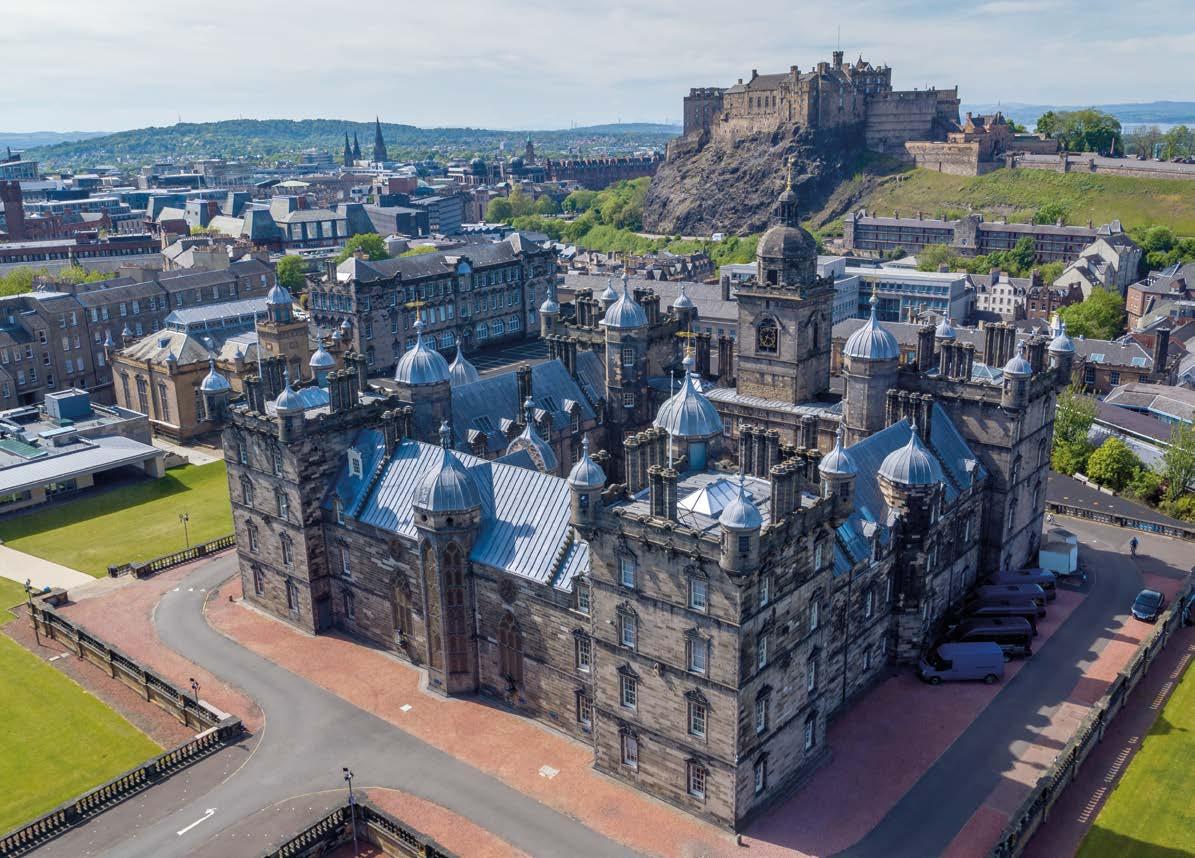
38 Quadrangle
A gift in your Will allows you to leave your mark on George Heriot’s and helps the school to fund more Foundation and bursary places.
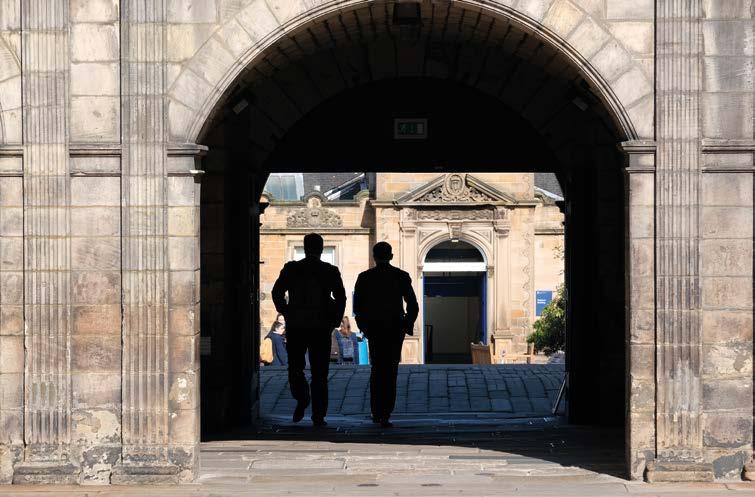
Legacy gifts are a flexible way of donating – there is no minimum, or maximum amount, donations can be pledged and updated at any point, they can be monetary, possessions, stocks/ shares, or a percentage of your estate.
A gift can be included in your Will at the time of writing or added through a codicil – a separate document that alters part of your Will but leaves the rest intact. In other words, a gift to Heriot’s can be included in your Will at any time. There is a reduction in the Inheritance Tax payable by your beneficiaries should you leave 10% or more of your estate to charity. This reduction can mean a gift to charity does not alter the final sum you had planned for your beneficiaries to receive.
The potential impact your legacy could have on the future of George Heriot’s School and its pupils is vast.

Whatever your motivation, we will recognise your pledge to leave a legacy by inviting you to join the 1628 Society – an exclusive community of potential Heriot’s
legators – which includes invites to school events and donor receptions, a Heriot’s lapel pin and a free copy of Jinglin’ Geordie’s Legacy by Brian Lockhart. After a legacy gift is realised, the donor will be honoured on our Legators Board, proudly displayed in the Refectory.
To learn more about why people leave a legacy, please read the
testimonials below from two members of the 1628 Society.
To find out more about making a gift to Heriot’s in your Will, or to notify us of your bequest, please contact the Development Office by email dev@george-heriots.com or call 0131 221 6716. We look forward to speaking with you. i
39 george-heriots.com
Why I am supporting Heriot’s in my Will: Former Pupils share their reasons for supporting the Foundation in their Wills.

‘Everyone will have fond memories of their time at Heriot’s, whether that be fun afternoons and Saturday mornings down at Goldenacre, walking out the school gates for lunch, enjoying a Rudi’s, or the friends they made and many of the great teachers we interacted with.
How we came to be a Herioter, for some is very different.
At the age of 13 I unfortunately lost my father to a sudden heart attack which made my whole world come crashing down around me and left me with a large void.
A few years earlier I had been introduced to Heriot’s RFC by a former Herioter David Grubb a good friend of my father and legend of a man. After the death of my father, he asked my mother if she had considered the Heriot’s Foundation. After applying I found out on my 14th birthday, I had been successful and would be starting in August 2006 into S3.
I was initially apprehensive that by being a Foundationer, I would be walking around with a sign on my back singling me out to be different. This could not have been any further from the truth.
Heriot’s puts every provision in place to support Foundationers, to merge us into the community and have equal opportunity. Whether that be, contribution to new uniform each year, new schoolbooks from Blacks, or covering the cost of school trips. I had the fortunate opportunity to go to Spain on a football tour, Berlin for a History trip, and Carbisdale Castle to name a few.
The pastoral support the staff offered was second to none. Many Herioter’s
may not know that each year there is a Foundationer dinner around June day which was attended by the staff and Governors and importantly the Foundationers. This provided us an opportunity to come together and for the Governors and staff to hear how our year had been and how best they could support the Foundation.
Heriot’s provided me, what I have come to reflect on, with a sanctuary. A chance to rebuild from what was a devastating period in my life. I arrived at Heriot’s a broken boy and left a man full of confidence and eager to see what the future held. I owe a great debt of
gratitude to the school and importantly the Foundation. This is why I have chosen to leave a portion of my Will to the school. I can never repay what the school has done for me, but I can hopefully afford someone else the same opportunity as I had.
So, I will conclude with a question, if you could give someone the same fantastic experience that you had at Heriot’s, who has just gone through a life changing experience would you? If the answer yes, then please consider leaving a small gift to the 1628 Society.’
– Aidan Duffy (2010)
40 Quadrangle
‘Back in 1982, a small sum of money left by an old relative gave me the opportunity to join Heriot’s in 5th year. I remember walking into the school for the first time – my first day in a school uniform, and an incredible view of the Castle which seemed to just sit on top of the buildings of the school. My year group came to introduce themselves in the playground, and I was immediately made to feel welcome and accepted. The year I spent at Heriot’s was, I think, the best year of my time at school. I made some life-long friends and gained enough qualifications to enter Medical School.
Years later, when my husband and I were moving our family to Edinburgh, I could only contemplate one school for them! My children also loved Heriot’s, where each of them has been happy, making great friends along the way. I first turned my thoughts towards making a Will just before the lockdown of 2020. As a doctor, I was aware of the rising mortality rates amongst health care workers, and also aware, that I would be on the front-line when the pandemic struck. I was aware of the 1628 Society and asked my solicitor to leave a part of my estate as a legacy to Heriot’s. This was an easy decision for me; without Heriot’s, I do not think I would have had the opportunity to study medicine – a small investment at a crucial time in my life. Heriot’s has given me such good memories, both from my time there and the time my children have spent in the school.
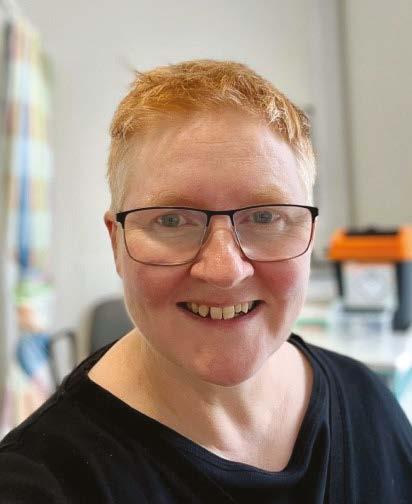
When I think about the difference the school has made to my life, leaving a legacy to the school seems like a small thing I can do which may give someone else the opportunity given to me; an opportunity which changed and shaped my life.’
– Jane McEachan (1983) i

41 george-heriots.com
Love on Lauriston
You never know what conversations will be had at one of our Former Pupil events. We had the pleasure of meeting Caroline (1980) and Robert (1980) on the evening of 24 May at One Bird Cage Walk.
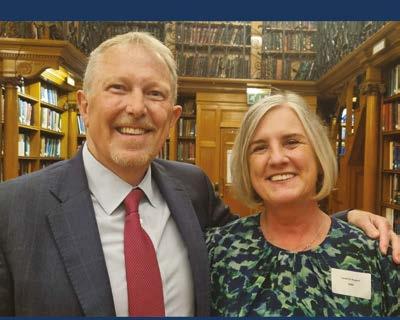
Caroline joined Heriot's in 1979, the first year that girls attended the school. While settling into the school Caroline (nee Catto) would meet Robert and a romance would bloom leading on to wedded bliss. If the progressive decision to start accepting girls into Heriot's was not made at that time our romantic duo may have been set on a different path.
The Nugents do now lay claim to being the first married couple produced by the school, while of course we will never claim this not to be so, we hand the baton over to you, our Former Pupils. Do you know of a Herioter couple that could lay claim to an earlier marriage?
If not, the Nugents can carry this accolade with pride!
We would love to read about more Heriot love stories, did you meet your life partner while at Heriot's? Do you have a
romantic story of being whisked off your feet from the Quad to Wedding Chapel? Did you marry on the school grounds, or have you reconnected with another Herioter you knew from your schooldays and found love has blossomed?
Please share your stories, after meeting the Nugents we cannot wait to hear more love stories from Lauriston Place.
Grahame and Gail Clark contacted us believing they could possibly challenge the Nugent's (because we failed) to include their date of marriage! But the Nugent's record as the first Herioter marriage stands having married in July 1987.
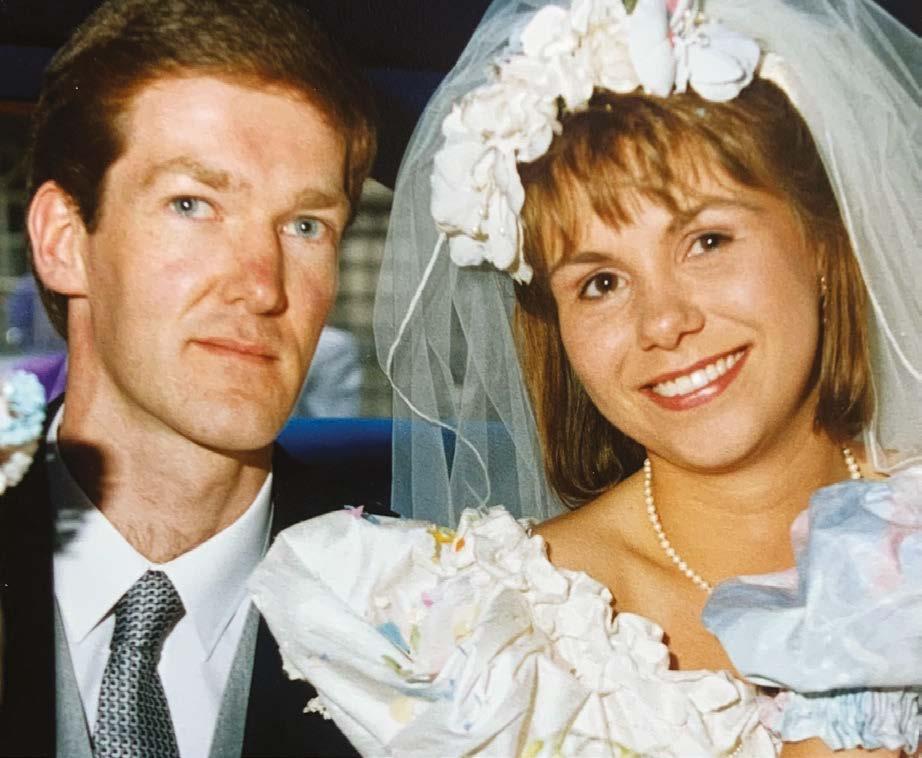
Grahame and Gail Clarke (nee Robertson) married in St. Giles Cathedral, Edinburgh in July 1989 after a long romance throughout their schooldays and beyond. Gail, like Caroline, was also in the first intake of girls in 1979 and Grahame had been at the school since 1973.
The wedding party was not short of Herioter's, in attendance were Stewart Barnes, and Dulcie Barnes (nee Hendrie), Former Teachers at the school, and another Former Teacher in attendance, Elaine
Clarke (Grahame's sister-in-law). Grahame's Best Man was Niall Stringer (former School Vice-Captain). Ushers on the day were all Herioters: David Clarke (brother) (1979), Alastair Reid & Calum Leys (1983) and David Robertson (1986).
Karen Warburton (1985) was Chief Bridesmaid to Gail and was supported by a further 7 Bridesmaids and a page boy (5 from Denmark).
I am sure you will agree a grand Herioter affair.
Can you beat the Nugent's 1987 record? Do you have a 'Love at Lauriston' story to share. Please contact us on dev@ george-heriots.com if you do, we would love to hear from you. i
42 Quadrangle
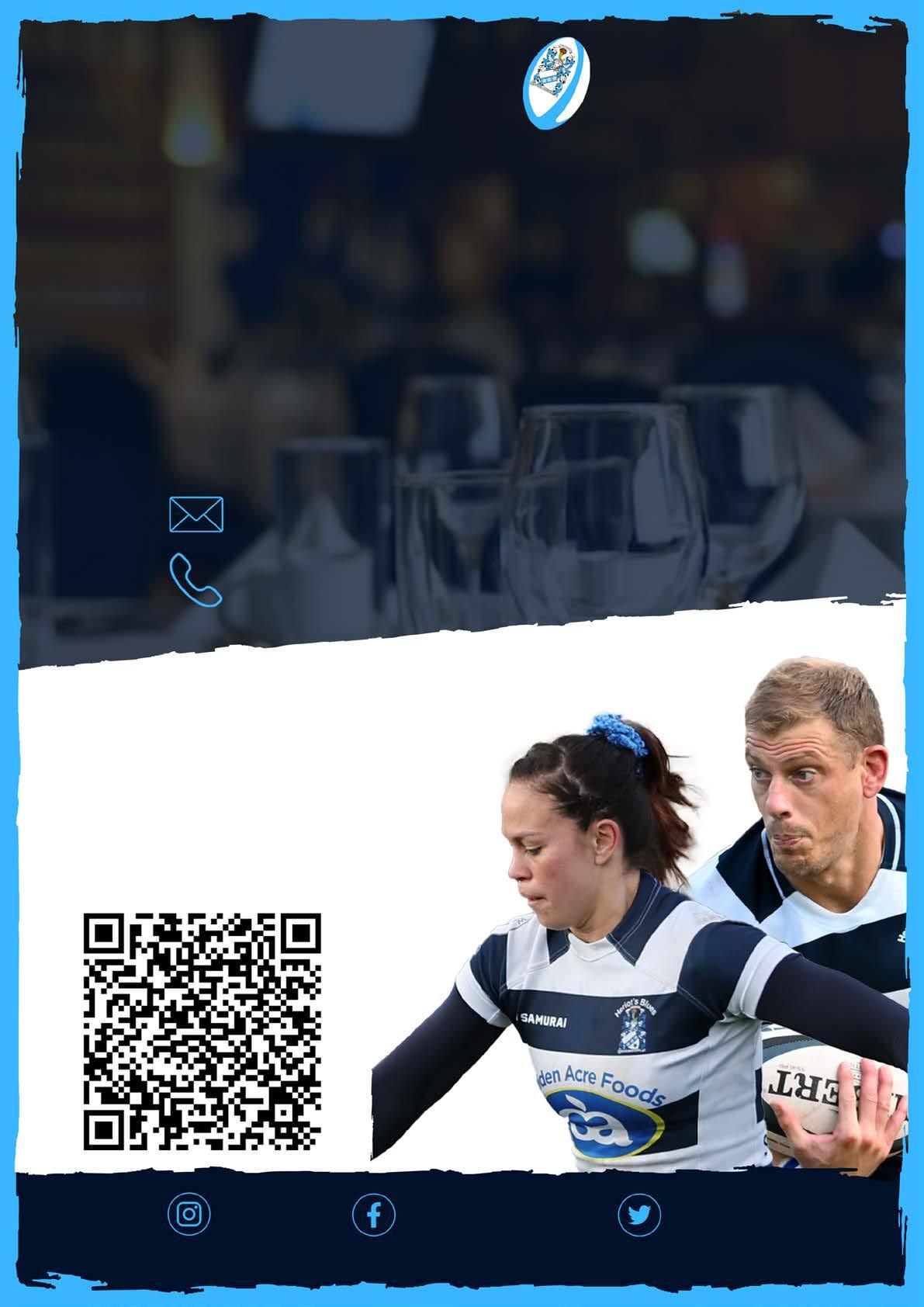


The director of the Moscow Circus School, training teenage clowns, jugglers, and acrobats, leaned forward at his desk, and said solemnly, “You must understand, the purpose of the circus in our Soviet Union is not only to entertain, but to educate the masses.”
It was sometimes a relief to get away from reporting on heavy politics and to go after lighter stories, for example an outing to the Mosfilm studios. Or to the circus school.
The director’s face remained unflinchingly bland as he made his pronouncement. He was following the official Party Line. But I had no doubt that, behind an expressionless mask of bureaucratic officialdom, he was doing what some wicked Highlanders do when they spin a yarn to unsuspecting southern visitors.
Moscow was a city in which dominating Soviet spires contrasted with ancient low buildings and a sprinkling of truly impressive early modernist architecture. The centrepiece of all was the Kremlin on Red Square with an unending queue waiting to visit the mausoleum and see the embalmed remains of the founder
of the Soviet state, Vladimir Lenin.
On my arrival in 1969, the street scene reminded me of Britain during the second world war when evening street lighting was dim, and many men rushed about in military uniform.
Foreign correspondents’ private apartments and offices were located in special blocks for foreigners.
As foreigners, we had problems making spontaneous contact with ordinary Muscovites. Although it was no longer illegal to have contact with foreigners, vestigial fears still haunted average Russians about hobnobbing with foreigners.
Gradually I got to know them. Russians are not only usually generous and friendly, but they also have a strong, often black, sense of humour which back then included barbed jokes about problems of daily life, whether shortages of some foodstuffs, or flat sharing with other families due to housing shortages.
One joke ran: a man enters a food store, asks: “Have you not got any milk?” Woman behind counter: “No. We don’t have any meat here. Go round the next corner to the left, there’s a store there
where they don’t have any milk.”
Apart from the Bolshoi Theatre and its magnificent opera and ballet, Moscow also had a lively straight theatre scene. I grew to enjoy especially the Taganka Theatre, which mounted the most inventive stage productions under its famous director Yuri Lyubimov.
Good restaurants were relatively few. However, Muscovites’ real entertainments were at home. Despite shortages, Russians were generous hosts. On the rare occasions when a foreigner was invited to their homes, they would offer a table with dishes piled high with meat, sausage, and fish, and with vodka and sometimes Georgian brandy in abundance.
Who dared invite foreigners' home? Sometimes it was Soviet journalists officially assigned as minders to foreign correspondents. Sometimes it was a new phenomenon in Moscow: political dissidents.
The ruling Communist Party had a monopoly of power and of information, whether over the press, radio and TV, book publishing or film studios.
There was no longer any censorship of foreign correspondents’ despatches.
44 Quadrangle
Former pupil Donald Armour (1958) worked as a Reuters staff correspondent between 1969-1973. Here he shares his memories of life in Moscow.
The news which we reported was divided between official and strictly unofficial. Official news was gleaned from the Soviet news agency TASS, or from the Soviet press, led by two dailies, the Communist Party organ Pravda, and the government organ Izvestia. All had the authority of government approval. Western embassy attachés could provide experts’ interpretations of sometimes baffling official press reports.
The unofficial news was often the most newsworthy by western standards. Dissidents had begun to protest openly at the restrictions to freedom of speech and perceived injustices under the Communist regime. Dissidents, few in number and marginalised in the heavily controlled political scene, belonged to a long Russian tradition of a critical intelligentsia minority alienated from the Russian masses, who believed in the principle of the strong leader.
Unofficial documents provided by these civil rights campaigners would reach western journalists with statements by more prominent rights activists such as the outspoken nuclear scientist Andrei Sakharov, doggedly criticising human
rights violations and pursuing the right to freedom of speech.
The police officers always on duty at the entrances to our foreigners’ compounds could be seen lifting their telephone receiver to report whenever we journalists brought in any guests, including dissidents.
If they were not directly involved officially, the Soviet public didn’t appear to take much interest in their government’s policies, rather like factory staff who just get on with their job and don’t give much thought to the management upstairs.
In 1964 the Soviet leader Nikita Khrushchev was suddenly overthrown by the Communist Party Central Committee, causing shockwaves worldwide. A British diplomat told me how he had been staying at the Ukraina Hotel just after this sensational news and overheard two cleaners looking at a TV screen showing a talking head. “Who’s that?” one asked.
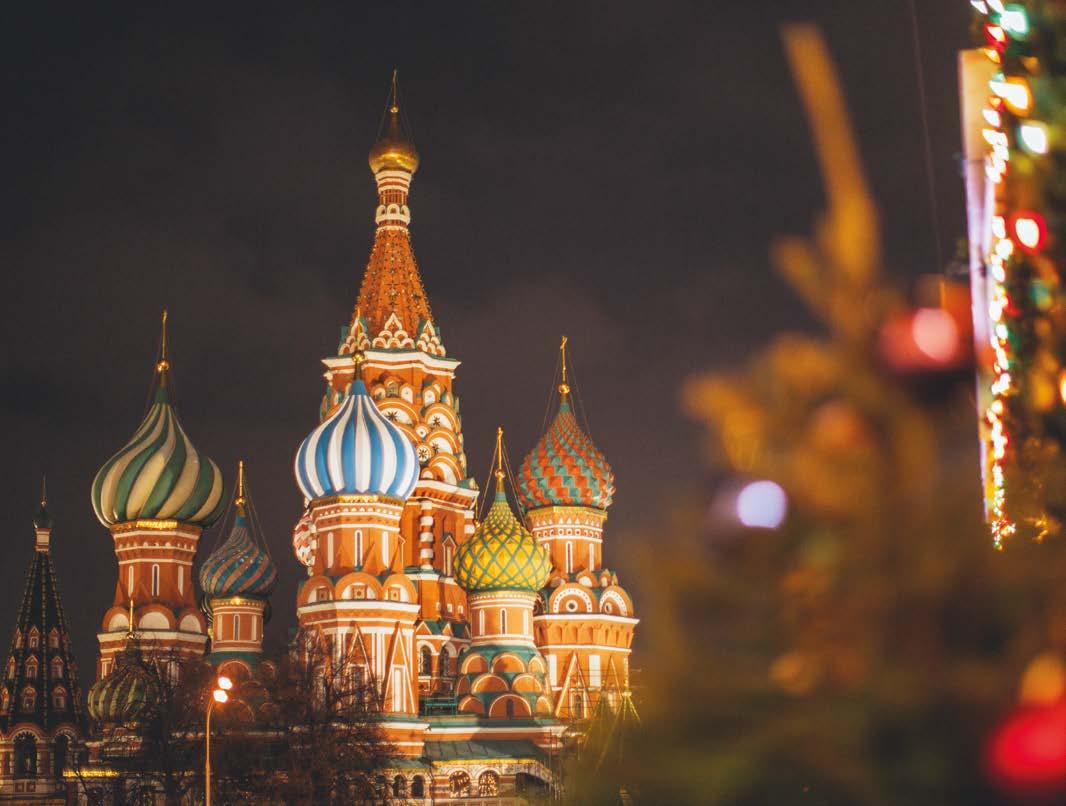
“Somebody called Brezhnev,” the other replied.
Leonid Brezhnev was the new Soviet leader succeeding Khrushchev.
Soviet schools? Despite ideological indoctrination, they were generally held to have high standards (including the circus school). My fellow Reuter correspondent in Moscow, Julian Nundy. believes that education was the main achievement of Soviet rule, thanks to Anatoly Lunacharsky, the first Soviet people’s commissar for education.
Some high schools even taught all subjects on the curriculum in foreign languages, such as English and French.
In 1970, ten months after his moon landing, Neil Armstrong visited Leningrad and Moscow. Two of us, Mike Johnson of the Associated Press, and I, followed Armstrong as he was shepherded around Leningrad, shepherded by his Soviet host, the cosmonaut Lt General Georgy Beregovoi.
We interviewed Armstrong in his suite at the Evropeskaya Hotel off Nevsky Prospekt. Halfway through, General Beregovoi, resplendent in the blue uniform of the Soviet air force, entered the room.
Beregovoi, who in 1968 commanded the Soviet Soyuz 3 orbiting mission, now
45 george-heriots.com
Photo by Elina Fairytale
banged on the table with his fist, pointed at his wristwatch and barked, "Davaete! Pora!" (Come on! It's time to go!)
Mike and I rose in the best Pavlovian tradition, but the evercourteous Armstrong, whose only visible sign of emotion at this intrusion was a slight twitch of the jaw, intervened: "Gentlemen, please remain seated. Let us continue."
The interview continued, while Beregovoi steamed gently in a corner.
Years after my assignment to Moscow, Mikhail Gorbachov became Soviet leader heading a team of reformers within the Communist Party, and quickly introduced utterly unexpected liberalising reforms. Perestroika and glasnost, meaning respectively reconstruction, and freedom of speech and openness.
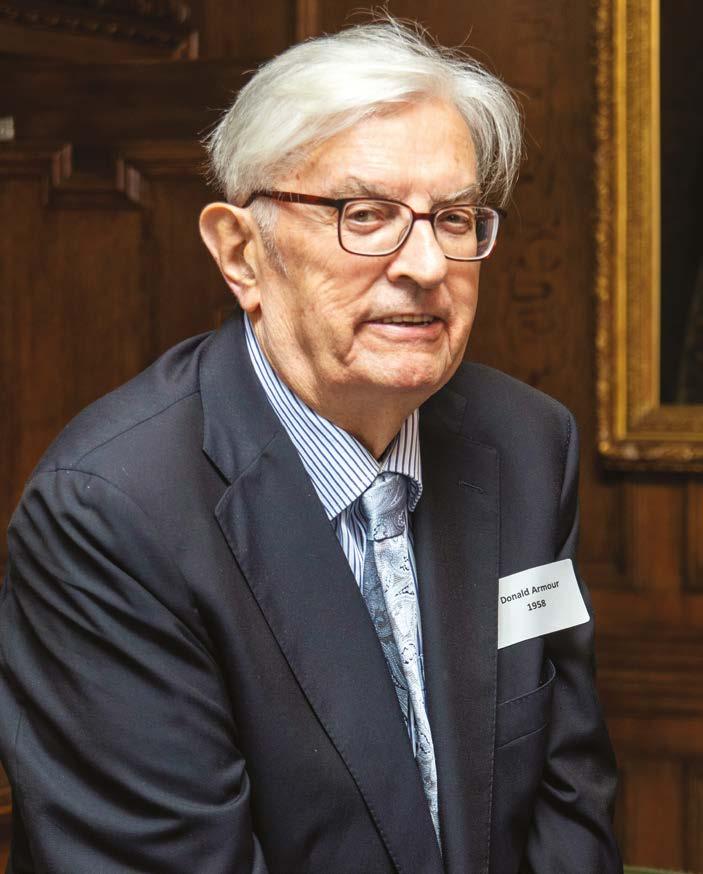
The media were set free from romantic falsehoods, myths, and glorifying fantasies about the Revolution, and from suppression of the full history of Josef Stalin’s totalitarian rule. Surreal revelations suddenly appeared on TV screens graphically displaying the 1930s Reign of Terror orchestrated by the dreaded secret police, called the NKVD.
It was not to last. After Gorbachov and his successor Yeltsin, a new tyrant, Vladimir Putin, suppressed the new freedom of speech and returned to the totalitarian state, even lauding Stalin.
During the brief idyll of the Gorbachov years, I returned to Russia, even visited the once closed city of Kazan with its own ancient kremlin and was received by generous hosts Andrei and Tamara in the new, relaxed spirit.
My hosts, both university lecturers, treated me with typical Russian hospitality, and also with glasnost -openness – posing frank questions, giving frank answers.
On my last evening they threw a farewell party for me. Again, Russian joy in living, Russian spontaneity, Russian humour, Russian culture. Russian hospitality.
An elderly guest, Yuri, sang Soviet songs from the second world war, the socalled “front-line songs,” moving ballads that were more than light entertainment, more like art born of the drama and
tragedy of war. Though now in his seventies, Yuri still preserved a fine tenor voice.
He also added final touches to my discovery of a Russia I had never known previously while a correspondent in Moscow under the old Soviet regime. Affected by vodka, I sat morosely wondering how cultivated, sophisticated Yuri could possibly ever have shared the same planet, let alone the same country,
with the butchers of Stalin's dreaded secret police, the NKVD, during the Reign of Terror.
Later I asked my host Andrei: “What did Yuri actually do for a living? A professional singer?”
“Yuri? No. He studied law.”
Andrei paused.
“And his first job was with the NKVD,” he added laconically. The singing NKVD man. i
46 Quadrangle
Donald Armour













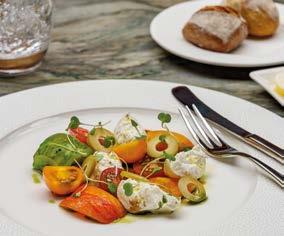
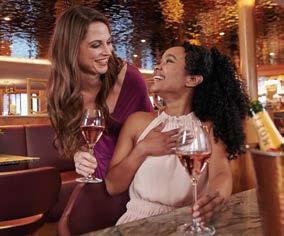
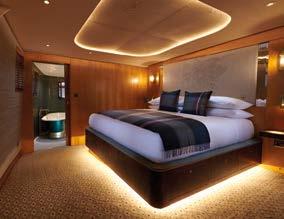
Escape the everyday aboard Fingal, Edinburgh’s luxury floating hotel FINGAL.CO.UK AA Five-Star Hotel, Hotel of the Year (PoB Hotels) george-heriots.com
In Memoriam
Scotland, Kenneth (1955)
Born 29 August 1936, Edinburgh
Died 7 January 2023, Edinburgh
Ken Scotland has earned a richly deserved place of honour in the history of Scottish rugby as one of his country’s greatest ever players. For those of a certain generation he represented all that was good about rugby, world class on the pitch and off it, a wonderful ambassador for the game as a complete gent whose self-effacing modest demeanour revealed no hint of his god like rugby status or his sporting competitive nature.
Recital of career statistics scarcely captures the flavour of his impact but for the record he won 27 Scotland caps, played in 5 Tests for the British and Irish Lions, represented the Barbarians, Edinburgh and North and Midlands Districts, The Army and Combined Services on many occasions, won 3 ‘Blues’ with Cambridge University and played club rugby with distinction for Heriot’s F.P.’s, Leicester, London Scottish, Ballymena and Aberdeenshire among others.
Ken will be particularly remembered for being one of the first attacking full backs, having been encouraged to join the line to create overlaps by his first captain at Cambridge, Welsh cap Geoff WindsorLewis, who recently made the trip from Wales to attend Ken’s funeral. Timing of his run and pace were key to the move’s success. He was also one of the first goal kickers to use his instep in the ‘round the corner’ style. Such ‘innovations’ helped make him a stand out on the 1959 Lions Tour of Australia and New Zealand, endearing him to that rugby mad nation. The Tour was “a great experience and great fun”, a personal success for Ken. “The enthusiasm for rugby there was a bit of an eye opener. You were noticed everywhere you went and at times I thought this must be what it’s like for Willie Bauld walking down Gorgie Road!,” name checking the great Hearts player of the time.
Kenneth James Forbes Scotland was the eldest child of parents John and Edith nee Forbes, brought up with brother Ronnie and sister Elsie near Heriot’s Goldenacre rugby ground. His father known as Jack was a senior Advocates’ Clerk in the capital’s Parliament House housing the Law Courts.
It was fortuitous that Ken lived in the shadow of Goldenacre. He and lifelong friend Eddie McKeating, a fellow Herioter and near neighbour, as youngsters regularly climbed over the wall ‘out of hours’ to kick a ball and play, initially to the groundsman’s chagrin. Eddie of course was also capped by Scotland with the pair making their international debut on the same day. It was a source of great pride for Ken in 2001 to have a new pavilion there named in his honour.
Interest in rugby grew through his father taking him to Inverleith to watch wartime Service internationals and in 1946 to Murrayfield to watch Scotland play the New Zealand Army, an unforgettable experience. He loved everything about it, “the players like gladiators, the noise of the crowd, it really fired my ambition to play for Scotland.” That became a driving force as his potential became apparent at Heriot’s where he played mostly at stand off in the 1st XV over three seasons and gained selection for Edinburgh and Scottish
Schools as well as the All Britain A.T.C. XV. He modelled his play on Jackie Kyle the great Irish no.10, earning widespread plaudits, being described by then rugby master George Blamire as “the schemer in chief… perhaps the most complete footballer Heriot’s has ever had.” Even when playing full back Ken thought “as a stand off ”.
Away from the sporting arena he was School Captain and Flight Sergeant in R.A.F. cadets. National Service with the Royal Signals based at Catterick followed as his rugby career developed down south with appearances for The Army and Combined Services leading to his first cap aged 20 as a full back against France at Colombes in Paris in January 1957. Conditions were dire with the dressing rooms “primitive” and crowd “seeming to be on top of you” as Ken marked his debut with a win scoring all Scotland’s points with a penalty and dropped goal after missing an earlier penalty, “Mistakes never bothered me very much,” as he recalled.
Next Cambridge University and an Honours degree in History and Economics awaited subject to passing a Latin exam for which he received tuition from retired Edinburgh Academy Headmaster A.L.F.Smith. Nevertheless it caused Ken difficulty and put him under pressure which carried over on to the rugby
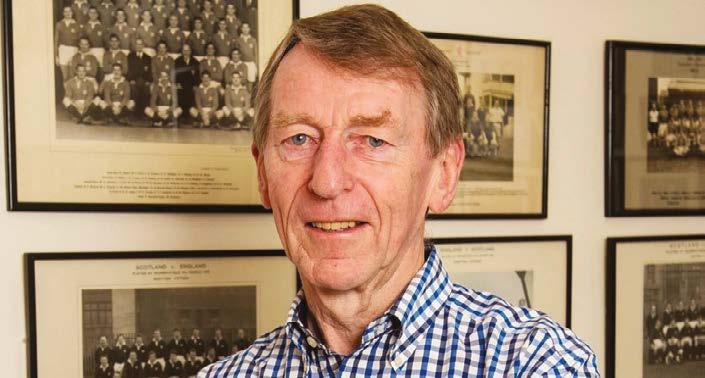
48 Quadrangle
field when he played “the worst game of my life” in the Freshers’ Trial.
After that sticky start his confidence returned with games for London Scottish before establishing himself in the University side for the Varsity matches, captaining the team in their 1960 win. Selection for the Lions ensued and he was a regular for Scotland until 1963 when employment took him to Aberdeen, entailing playing for ‘open club’ Aberdeenshire. Although he thoroughly enjoyed his rugby with Aberdeenshire, their lower level fixtures did not enhance his international career.
To his credit he persevered and won a final cap in 1965 enabling him to surpass Dan Drysdale’s record total of international caps for a Herioter. While in Aberdeen he was a regular for North and Midlands including games against the touring All Blacks and Australians before hanging up his boots in 1969.
On 3 April 1961 at St. Andrews Church, Juniper Green, Ken married Doreen Marshall whom he had met through friends at school dances. They shared almost 62 years of happy marriage during which they had three sons, Robin, Iain and Alistair.
After Cambridge Ken worked initially in management consultancy in

the Midlands while playing for Leicester before moving back to Scotland where he took up a post in Aberdeen with Hall’s, Builders, later becoming Deputy Managing Director with Aberdeen Construction Group. After ten years in Aberdeen the family returned to Edinburgh where Ken worked in house construction with the Walker Group and Salvesens and was a non executive Director on the Scottish Postal Board.
In 2020 he wrote an excellent memoir, Ken Scotland – The Autobiography, an outstanding read marked by his insight, candour, modesty and subtle humour. Reflecting his impact, when Tom Kiernan the legendary Irish and Lions captain was interviewed on the occasion of his 50th cap and asked ‘Who is the greatest player of your time? – he replied –“Ken Scotland, it was a privilege to be on the same field as him.”
Ken was an unassuming, honest gent who treated everyone the same, irrespective of station in life. Doreen has asked that her appreciation of the fantastic support she has received from her sons at this difficult time be recorded. Ken is survived by Doreen, their sons, his siblings, seven grandchildren and six great grandchildren.
– Jack Davidson
Kenny Scotland, Andy Irvine to the Watsonian Hastings brothers, and had an astonishing statistical knowledge of players’ careers. Such was his dedication that having served his old school in so many directions, well into his eighties he could still be seen on duty at the gate or in his yellow jacket acting as a steward.
A scholarship pupil of Robert Gordon's College and later a first class honours graduate of Classics at the University of Aberdeen, Henry went on to study at Pembroke College, Cambridge.
Henry's academic career took him to Teacher Training at Marischal College, Aberdeen. Thereafter he was appointed Head of Classics at Kirkcudbright Academy, followed by a post as Head of Classics at Beath Academy in Cowdenbeath.
In 1962, Henry switched direction and joined HM Inspectorate of Schools, a role which saw him serve over 6 years in Edinburgh, then Glasgow.
In 1969 he returned to Edinburgh as Headmaster of Liberton High School where he remained until he took early retirement at the age of 57 in 1985.
Hill, Douglas (1955), died 9 March 2023

His own years at Heriot’s with his brother gave Douglas a love of his old school that became a devotion. He was a personal friend of many of the top rugby names from
As one Scotsman Publications managing director said: “Every company should have a Douglas Hill, but there is only one of him in the world. And we have him, thank goodness.”
The archetypal family man, he is survived by his wife Lillian, daughter Alison, grandson Rhuairi and brother Blair.
– by Ian Nimmo, for The Scotsman
Life in retirement saw Henry as busy as ever. As an Elder at Reid Memorial Church, he had the opportunity to serve as Education representative on Edinburgh Presbytery which led to him joining the Board of Governors at Heriot’s in 1997.
Henry is survived by his daughter Marjory, grandsons
Iain and Calum and his 4 greatgrandchildren, all of whom gave him great joy and pride.
Philip, Henry Leslie died 14 April 2023
49 george-heriots.com
In Memoriam
Former Pupils
Bairnson, Ian (1970), died 7 April 2023
Bell, Thomas (1954), died 19 February 2023
Bennett, John A E (1953), died 24 October 2022
Berwick, Donald (1947), died 23 January 2023
Bissett Dunbar, Charles (1957), died 15 February 2022
Brown, Douglas (1953), died June 2022
Buchan, John (1947), died 10 October 2022
Clark, Robert (1950), died 28 November 2022
Crawford, Victor (1947), died October 2022
Cumming, Allan (1952), died 5 April 2023
Cumming, Gordon (1959), died 8 April 2022
Cunningham, Tom (1964), died 10 June 2023
Edwards, George (1948), died 23 October 2022
Farish, Brian (1954), died 27 January 2023
Fisher, Norman (1961), died 17 November 2022
Fraser, Scott (1982), died 12 December 2022
Gebbie, Norman (1948), died 25 March 2023
Godfree (nee Pyatt), Ruth (1995), died 14 April 2023
Good, Alexander (1944), died 14 December 2022
Grubb, David (1981), died 19 January 2023
Harnden, David. (1950), died 3 October 2022
Heggie, Colin (1970), died 19 September 2022
Hendry, Duncan (1969), died 2 March 2023
Heywood, Prof, Vernon (1945), died 17 September 2022
Holt, Keith (1961), died 4 July 2023
Hogg, Walter (1952), died January 2023
Horberry, John Alexander (Ian) (1954), died January 2023
Howell, Denis (1967), died 3 November 2022
Hunter, Robert (1947), died 10 August 2023
Keatinge, Alastair (1976), died 20 October 2022
Keddie, Gordon (1962), died 19 May 2023
Kirkpatrick, Michael (1953), died 1 August 2023
Longmore, Anthon (2015), died 16 January 2023
Lyne, Ronald (1947), died 10 October 2022
Maconochie, William (Bill) (1951), died 28 February 2023
Mason, Pat (George) (1969), died 1 August 2023
McGill, David (1965), died 21 January 2022
Miller, David (1952), died 18 July 2023
Milligan, Graeme (1968), died 8 September 2022
Mitchell, Ian (1962), died 23 March 2023
Moir. Alastair (1954), died 13 July 2023
Naysmith, Douglas (John) (1959), died 2 July 2023
Nicol, William (Bill) (1954), died 21 October 2021
O’Riordan, Rory (1959), died 9 May 2023
Ritchie, Peter (2001), died 31 October 2022
Robertson, John (1956), died 17 November 2022
Sellers, John (Jock), (1944), died 22 February 2023
Smale, Thomas (1946), died March 2020
Smith, (Nee Fitchett), Hannah (2004), died 19 March 2023
Spalding, Alan (1948), died 25 September 2022
Stewart, George (1958), died 9 September 2022
Storey, Gerald Francis (1944), died 6 January 2023
Ferrie Watt, Robert (1954), died 1 December 2022
Webster, Thomas (1940), died 6 December 2021
Wightman, Andrew JS (1947), died 12 August 2022
Wood. David (1962), died 4 February 2023
Former Governors
Dow, Douglas, Rear Admiral (1953), died 5 December 2022 (FP)
Philips, Henry (1962), died 14 April 2023
Hill, Douglas (1955), died 9 March 2023 (FP)
Former Staff
Jardine, Jim (Former Teacher), died 18 January 2023
Neill (sic), Robert (Bob) (Former Teacher), died 17 January 2023
Niulala, Suli. (Former Teacher), died 28 November 2022 i
50 Quadrangle
George Heriot’s Trust Supporters 1 January 2022 – 31 December 2022
The Principal and Governors wish to express their warmest thanks to all Herioters, Current and Former Parents and Friends of the School who generously made donations in 2022. Your gifts are so gratefully received and allow us to maintain Heriot’s excellence for future generations.
Class of 1940’s
Jane and Neil Duncan
Mr and Mrs Lornie
Lord Mackay of Clashfern
Mr Maurice McIlwrick
H. N. Williams
Class of 1950’s
Norman and Maureen Anderson
Peter Brunton
R E Dow
David Doyle
George Gordon
In Memory of Mr Douglas Hill
Dr Norman Irons CBE., DL.
R J M Wilson
Will Mathieson
W.L.McClure
Bill and Janet McDonald
Willie McVicar
Alistair Moir OBE
Eric Robertson
H Steers
Douglas Stobie
David Syme
Robert Todd
Class of 1960’s
Douglas Amos
David Bishop
J Borthwick
D S Bruce
I Duncanson
John R R Fowler
Mr Mike & Mrs Win Gilbert
Ian D Gillian
R. Grahamslaw
Duncan Grant
Dr. George Holywell
N E Leslie
Douglas J May
Rennie McElroy
Andrew Milne
R V Pringle
David J Randall
Douglas W. Roberts
Malcolm Smith in memory of Jean Patrick helped by Heriot's in the 1930s
Gordon Watson
Andy and Kerry Watt
Mr J D Wood
Dr. John Wrench
John Yellowlees on behalf of Saltire Society Scotland Branch
Class of 1970’s
Joni Bryce
Robin Carmichael
Alistair Clark
James Coxson
Ian Gray – The Hugh Maclennan Fund (to support bursary pupils less able to afford the cost of books, uniform, travel, lunch etc)
A. Ramage
Murray Shepherd
Boyd Taylor
James Thomson
Cameron Wyllie
Class of 1980’s
Rhona & Richie Adams
Michael Beveridge
Hugh Dickson
Patrick and Anna Edwardson
Graham Harkness
Harry Hogg
Class of 1990’s
Justin D'Agostino
Anton Nelson
Class of 2000’s
Chris Sibbald
Michael Tai
Friends of Heriot’s and former/current staff
Alexander family
George C. Borthwick
Cuminga Family Trust
Tracy Daniels
Family of Kaspar Diamond
Robert and Janice Dickson
Mr Rob Dobson and Ms Judith Wilson
Lesley Franklin
Mr and Mrs Alastair Fraser
Emma Lawrence (formerly Griffiths)
Miranda Henderson
Chris Ireland
William Jackson
Michael Kerr in memory of my beloved wife Dorothy
Norman & Maureen Mathison
Michael and Angela McFee
Henry Philip
S&P Quinn
Maggie Salmond
Craig Smith
Daniel & Deborah Sorin
Mr Andrew Thackrey
Laura, Max and Daisy Thomas
Gordon and Paddy Turner, New Zealand
Appeals
All those who donated so generously to the “Fab Fore” golfing challenge appeal. All those who supported the “460km for Foundation400” appeal.
Legacies
George Heriot’s is extremely grateful to all those who pledge to leave a legacy to the School in their will. In 2022, the Foundation benefitted from the transformative gifts left by 5 legators whose generosity will continue to impact generations of Heriot’s pupils.
We would also like to express our warmest thanks to those donors who wished their gift to remain anonymous.
i
Our very grateful thanks to all our donors. 51 george-heriots.com
Principal’s Last Word Gareth Warren
As someone with a life-long interest in History, becoming a member of the Heriot’s family adds a certain richness to my role as Principal. Naturally the day to day focus is on the pupils and creating the best possible educational experience but there are times, for example as I traverse the quadrangle, that I spot a masonary design that piques my interest and I create a mental note to, one day, find out a little bit more of the background on that stonework.
Reading Quadrangle creates a similar experience. The unearthing of our past History is a subject I found fascinating, whether the latest ‘finds’ on our Founder or the impact of a teacher, in this case Bob Neill, and his legacy that exists so strongly today. This edition provides the fine balance between the proud traditions of the past, the news of the current, and the plans for the future.
This is a significant year for the School marking the 400th anniversary of the death of George Heriot; an opportunity to mark this occasion with philanthropy in action through our Giving Week. Great ideas have already emerged and I encourage your
participation, in whatever guise, to achieve our target of raising funds to educate a bursary pupil through their Senior School career.
There is a discernible sense of activity growing across the FP community, mirrored by the increasing numbers participating in the Herioter Hub. Former pupil events are lively, enjoyable occasions, whether our coffee mornings or gatherings, with plans to expand the School’s connections within
the UK and further afield. If you have the chance to be involved, it would be lovely to see you there.
Finally, I would publicly wish to welcome our new Herioter President, Morgan Jamieson, our new School Captains and our new members of the Development team. They are great and have added a real dynamism with a wish to provide an exceptional service for you as FPs. Please get in touch with them, they would love to hear from you. i
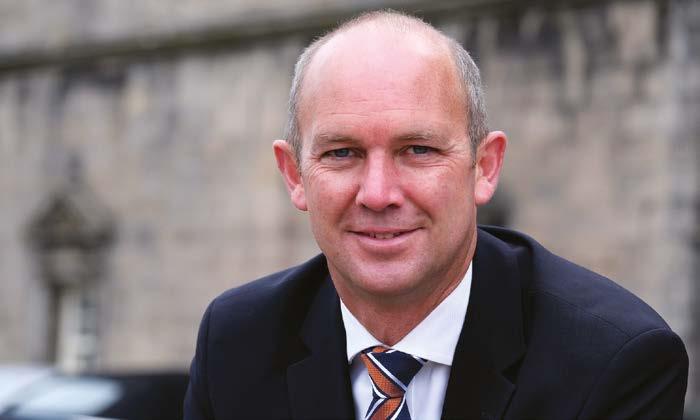
52 Quadrangle
KITH

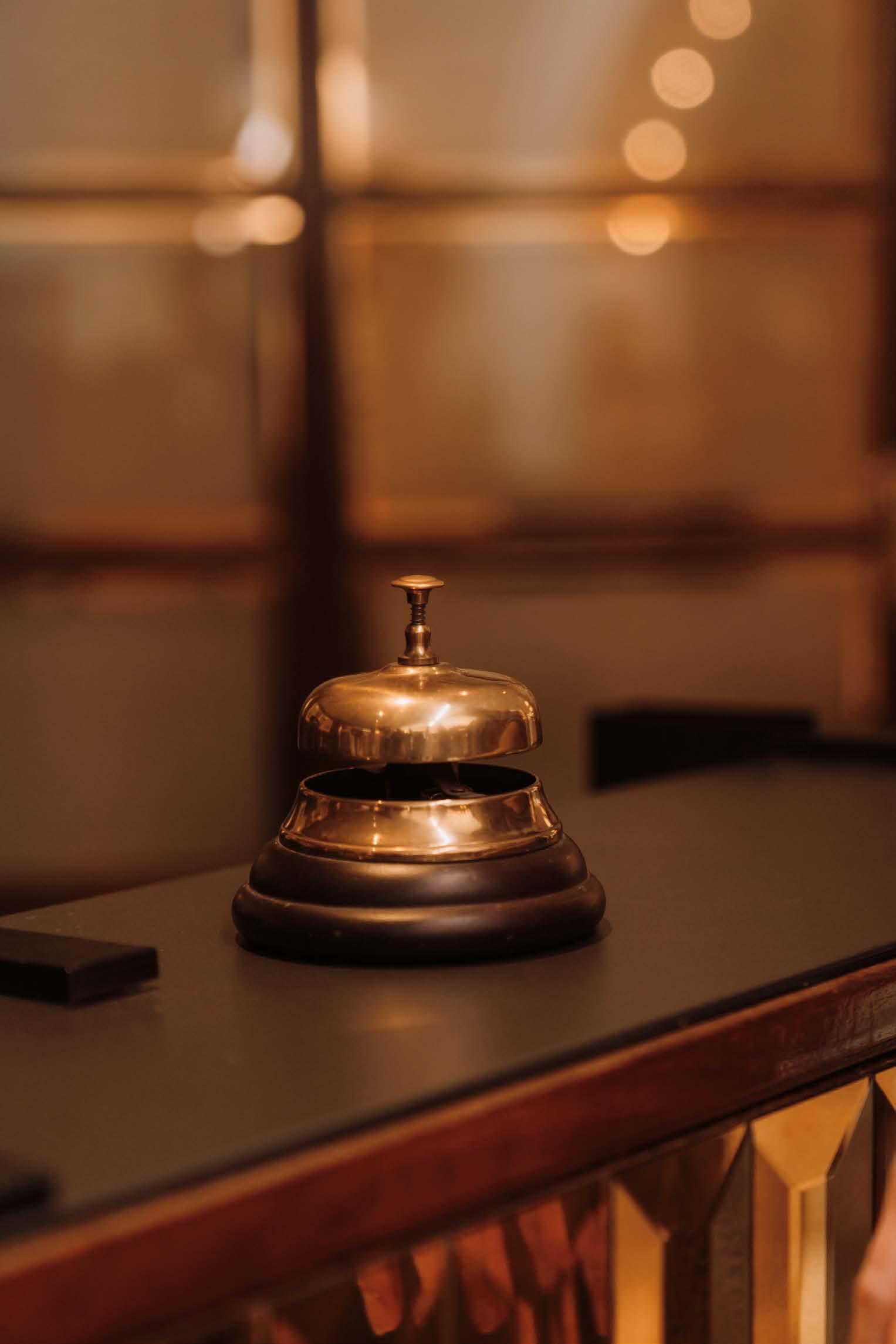
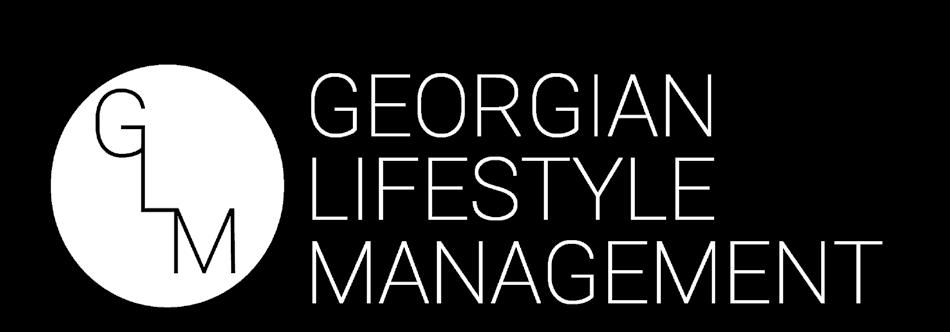
www.georgianlifestylemanagement.co.uk Life can be complex; we simplify it.

















































 Maddy Counsell (2021)
Maddy Counsell (2021)











 Sketches on the reverse of a 1606 to Queen Anne, perhaps evidence of jewellery designed by George Heriot?
Sketches on the reverse of a 1606 to Queen Anne, perhaps evidence of jewellery designed by George Heriot?

 The Lyte Jewel: portrait of King James VI of Scotland and I of England. Copyright British Museum.
The Lyte Jewel: portrait of King James VI of Scotland and I of England. Copyright British Museum.




 By Ruth Armet
Clockwise from above: Mrs Ruth Armet, Junior School Teacher, retired 2010.
By Ruth Armet
Clockwise from above: Mrs Ruth Armet, Junior School Teacher, retired 2010.




 Herioter President medal The Dux medal
Herioter President medal The Dux medal




























